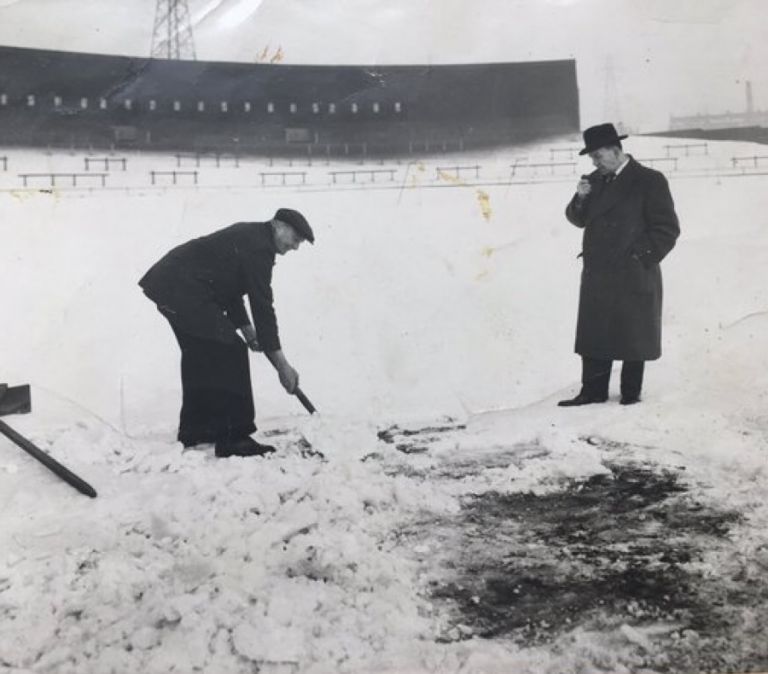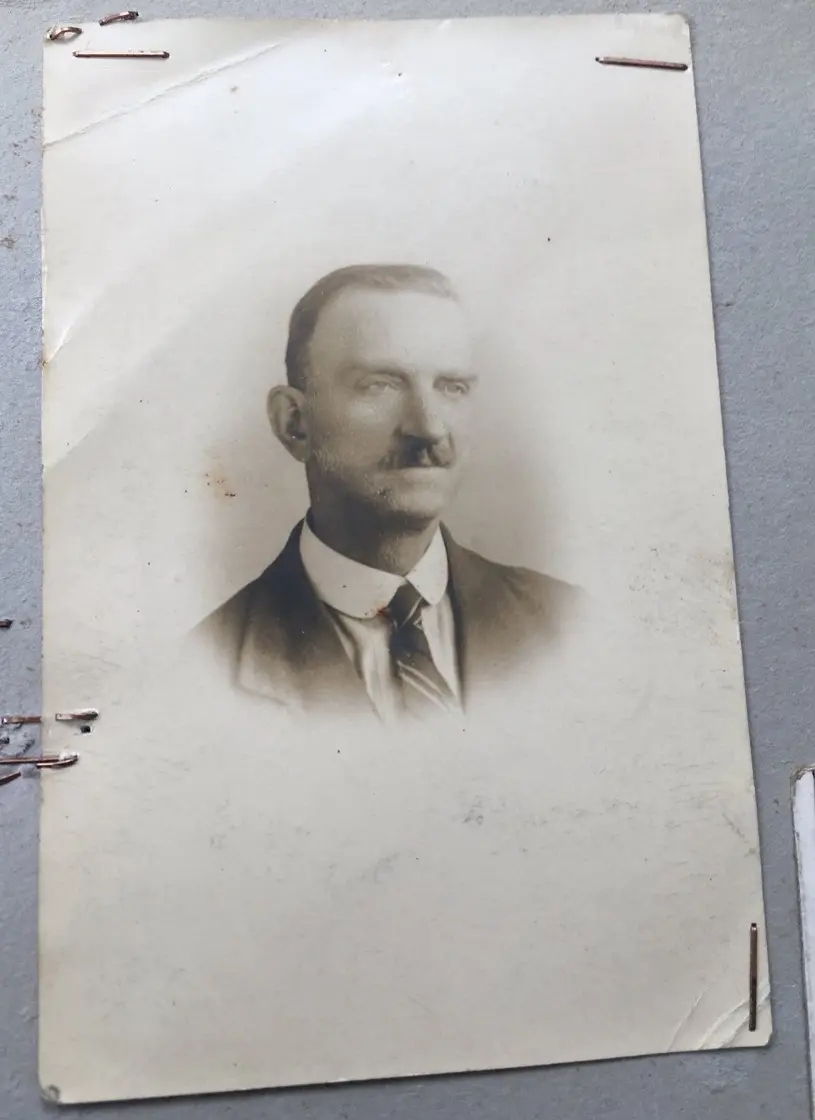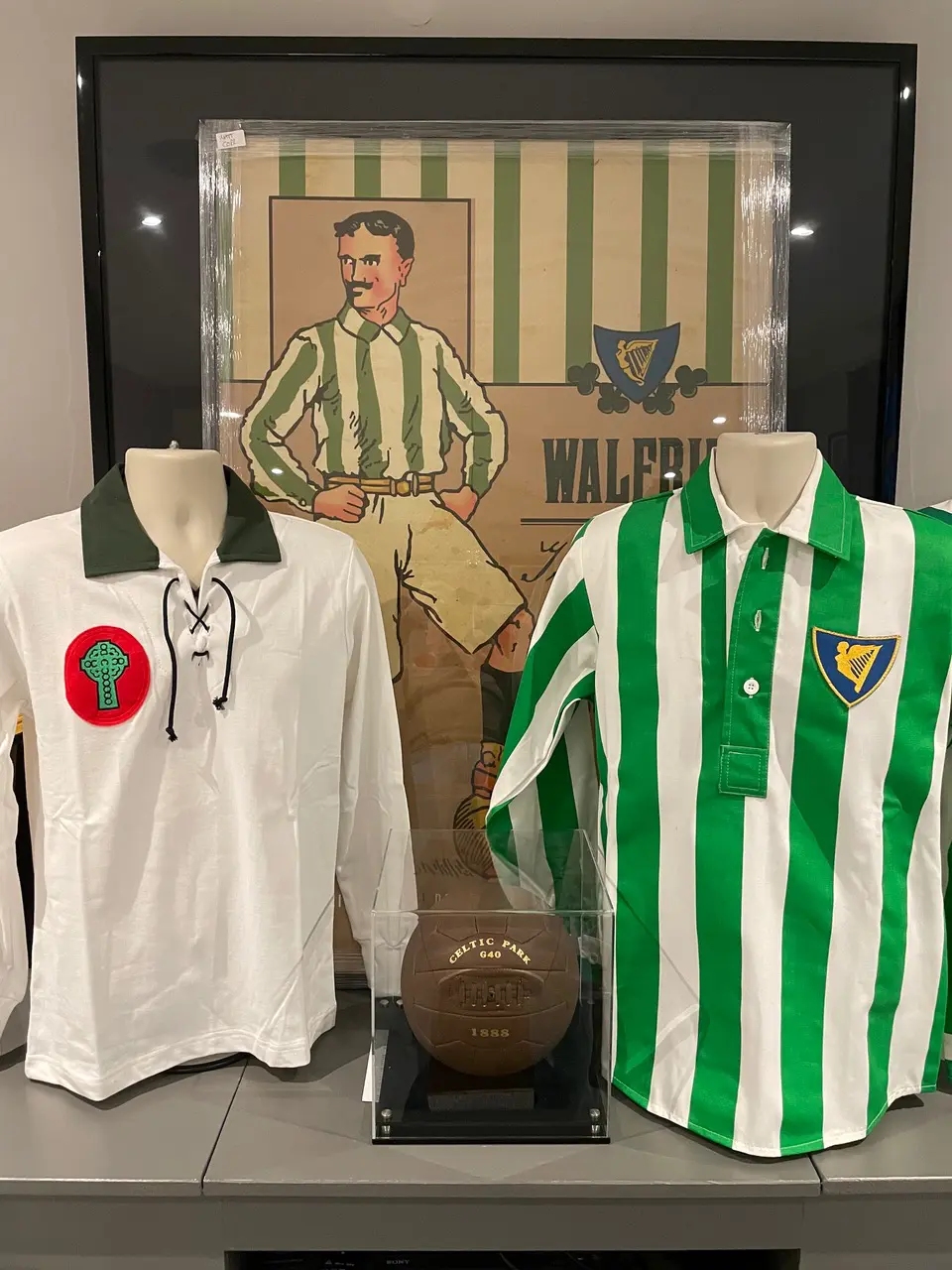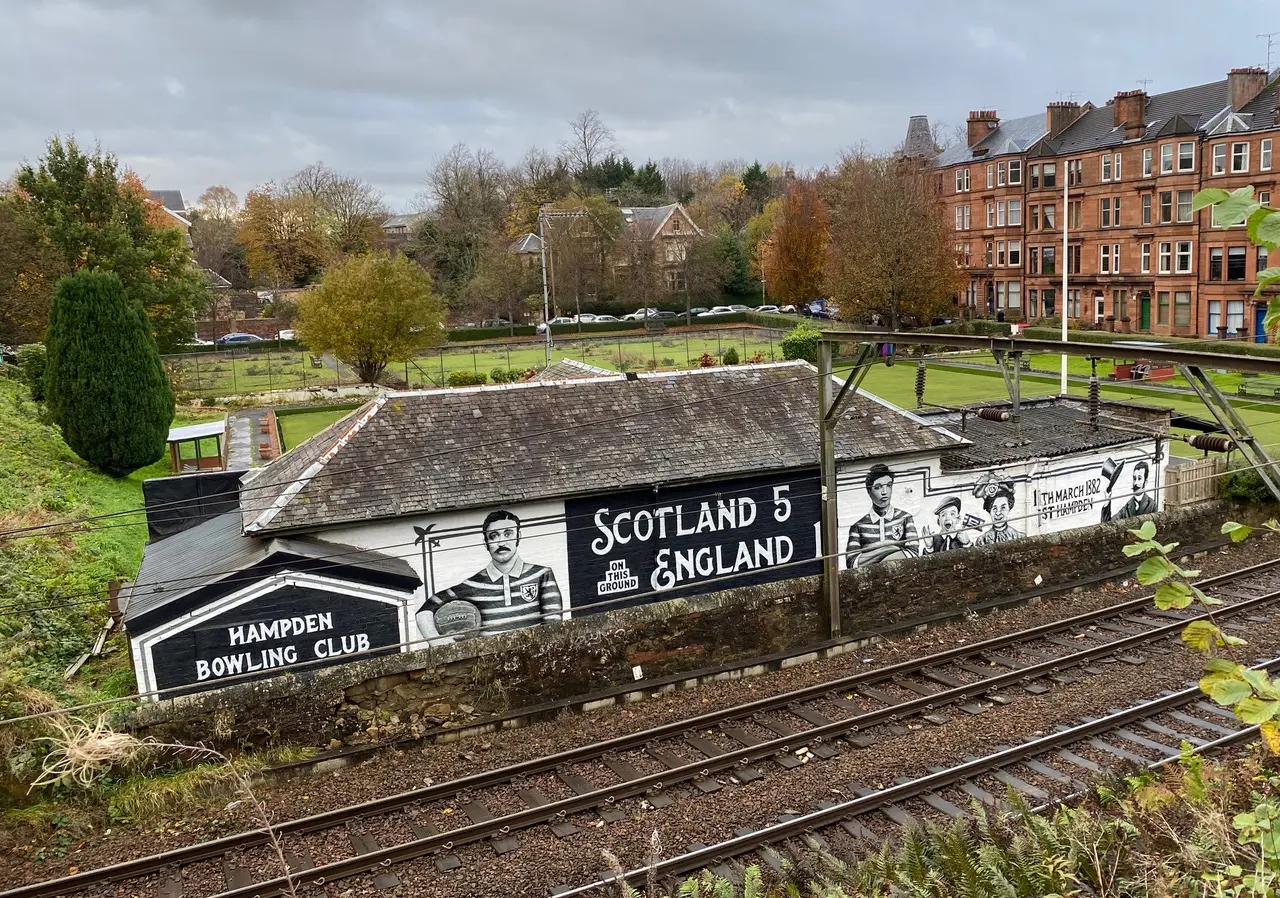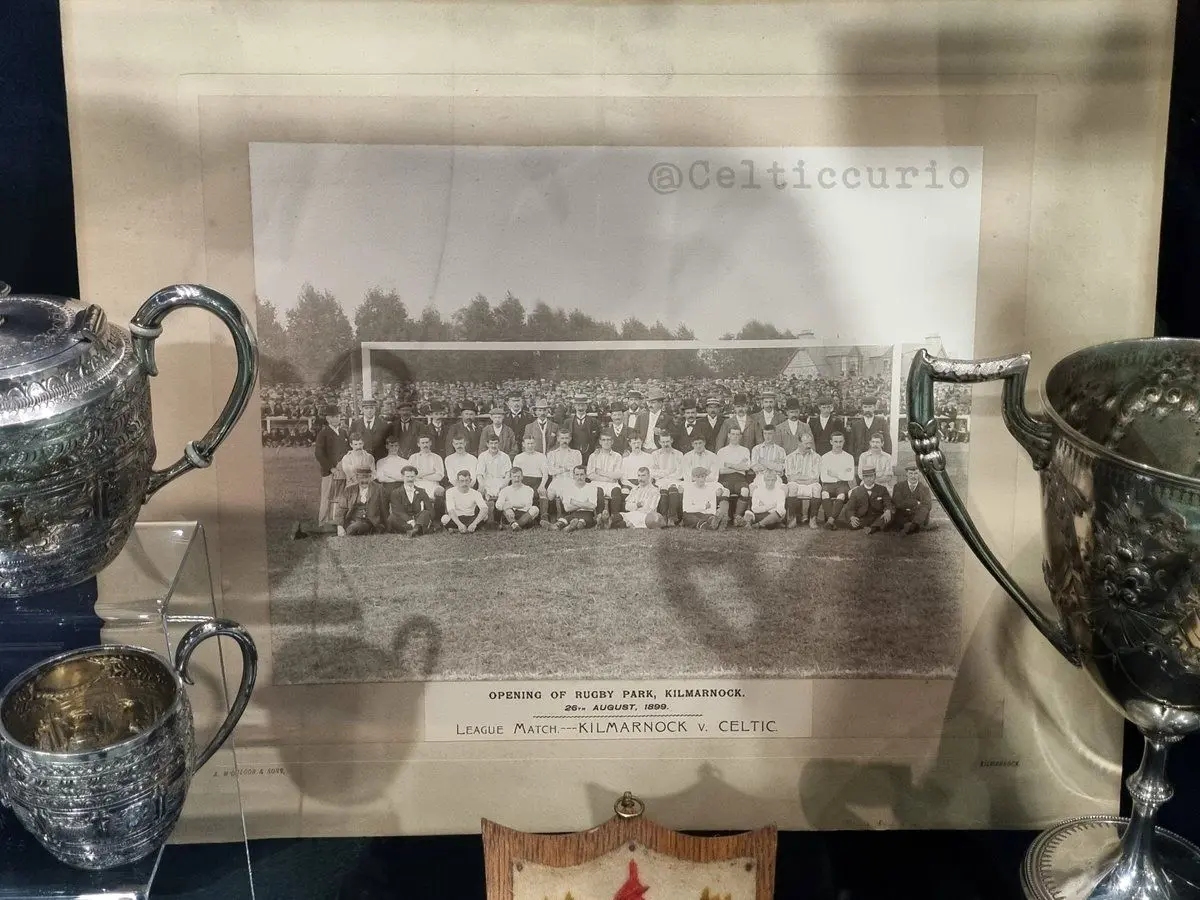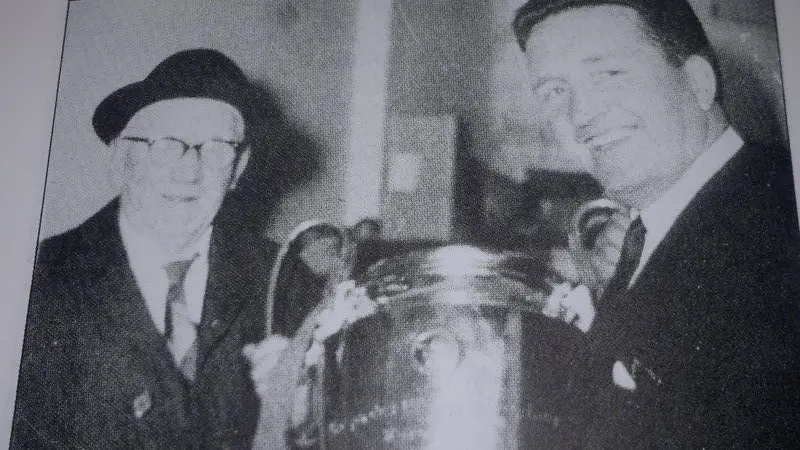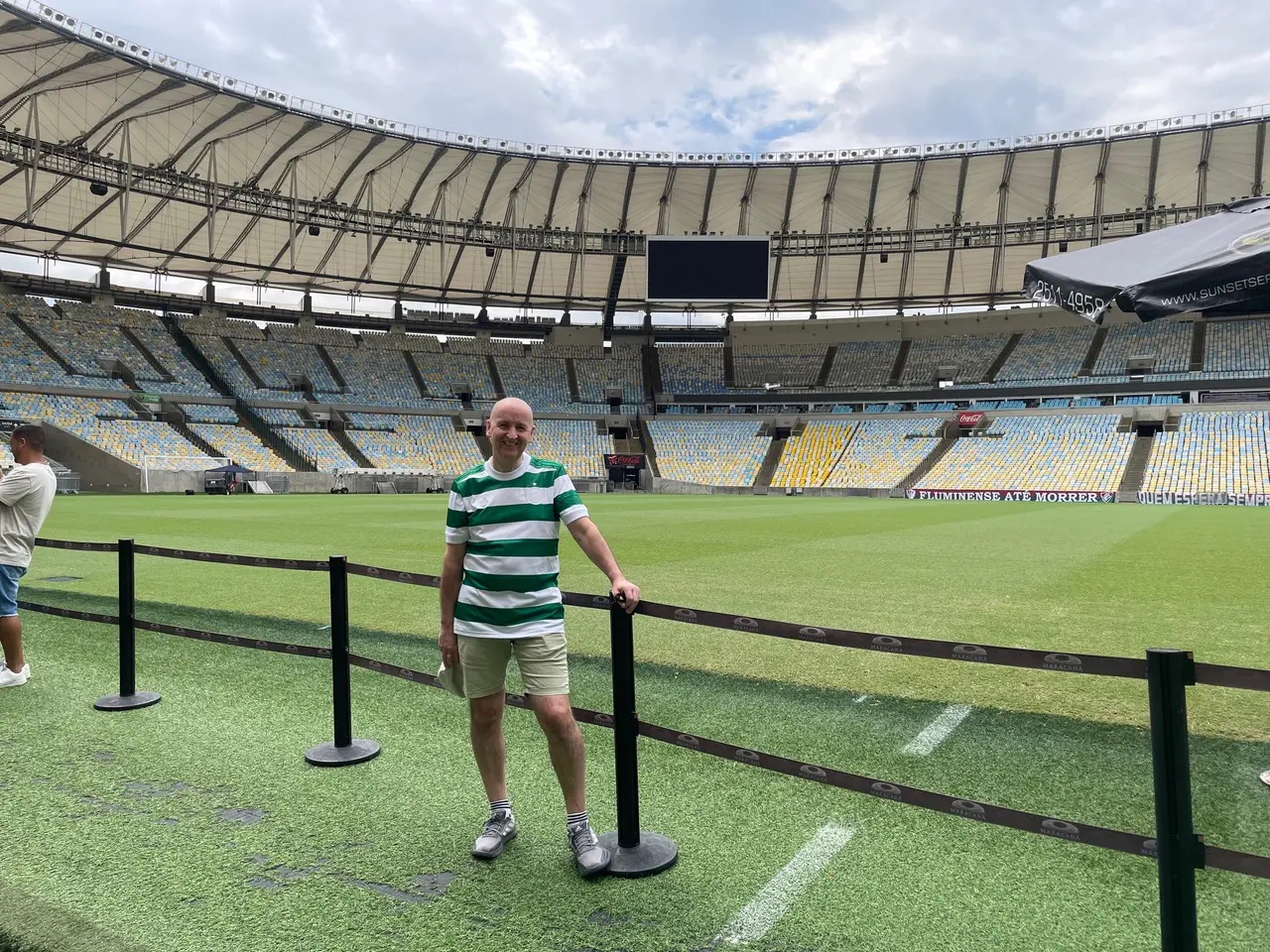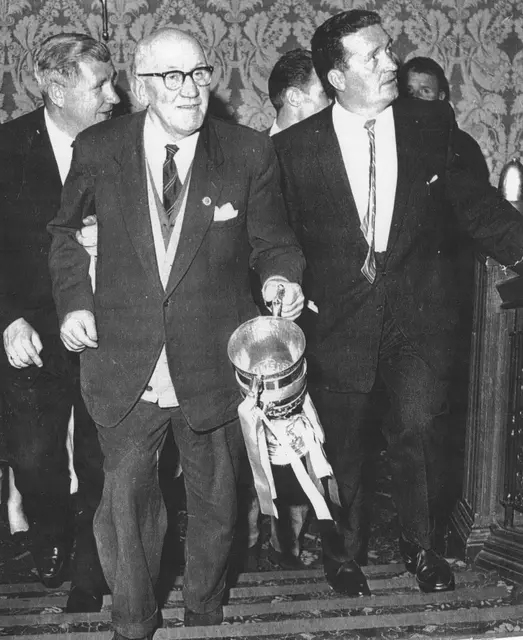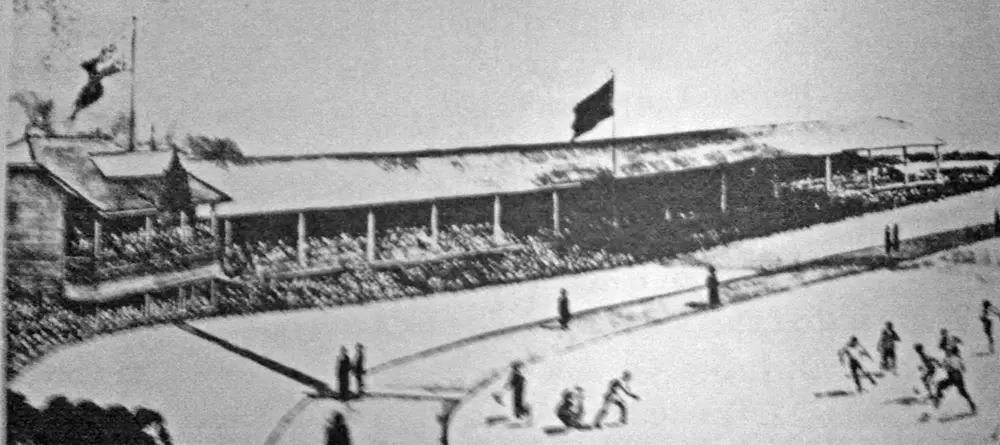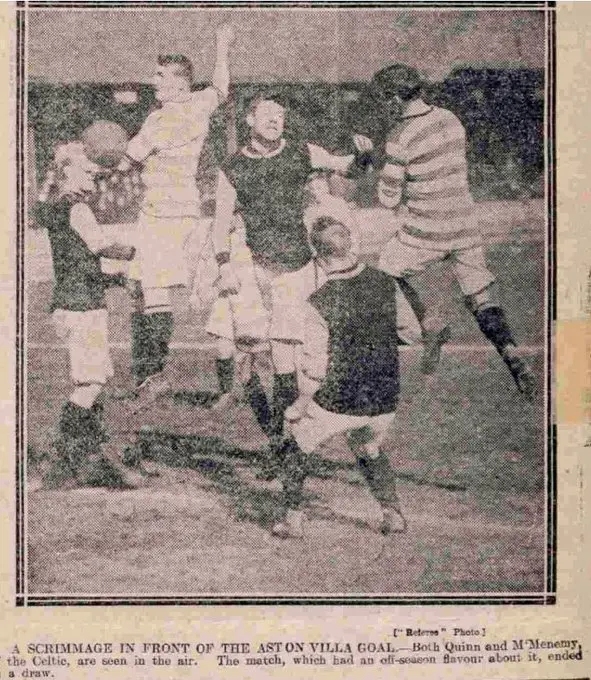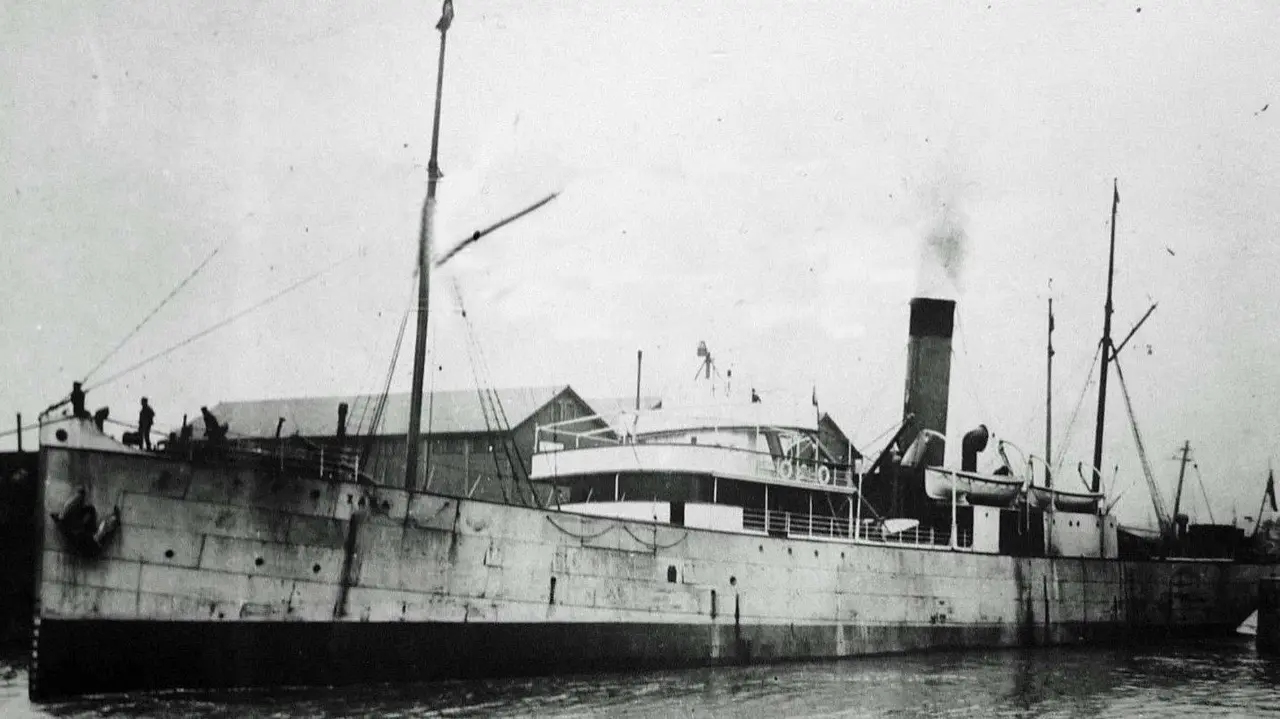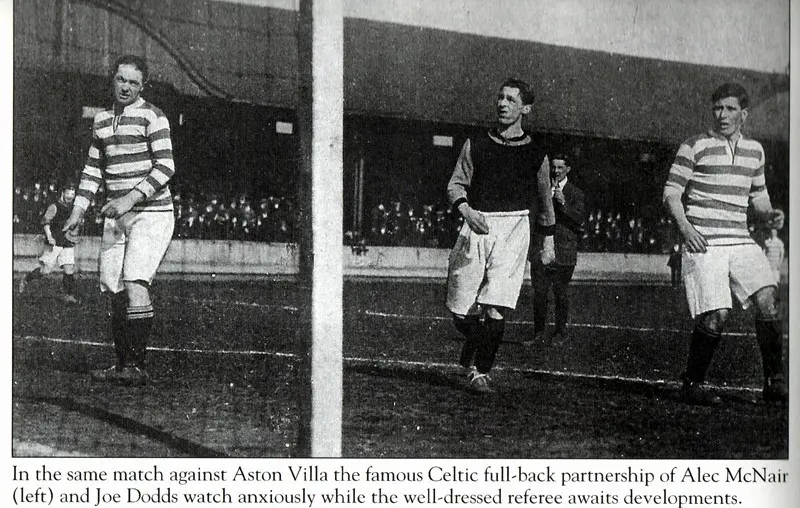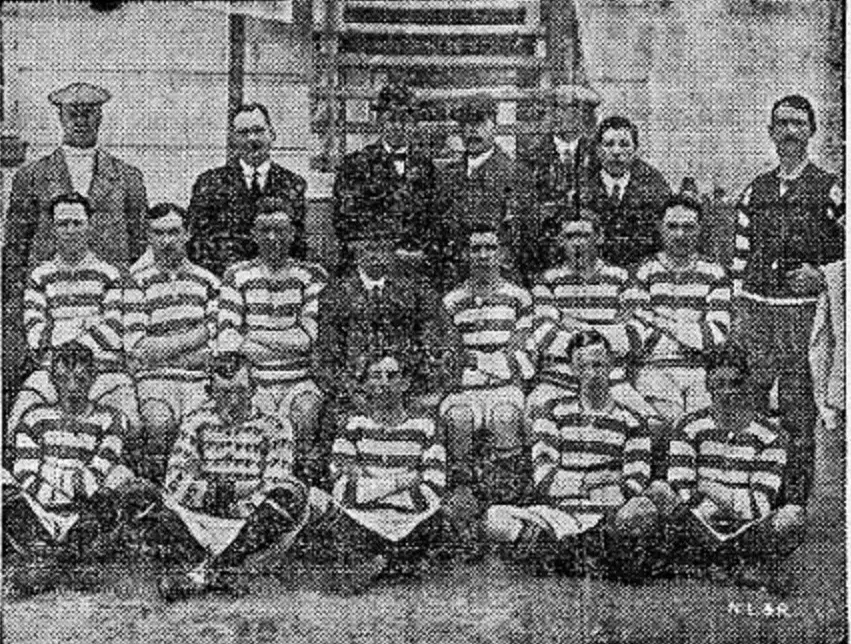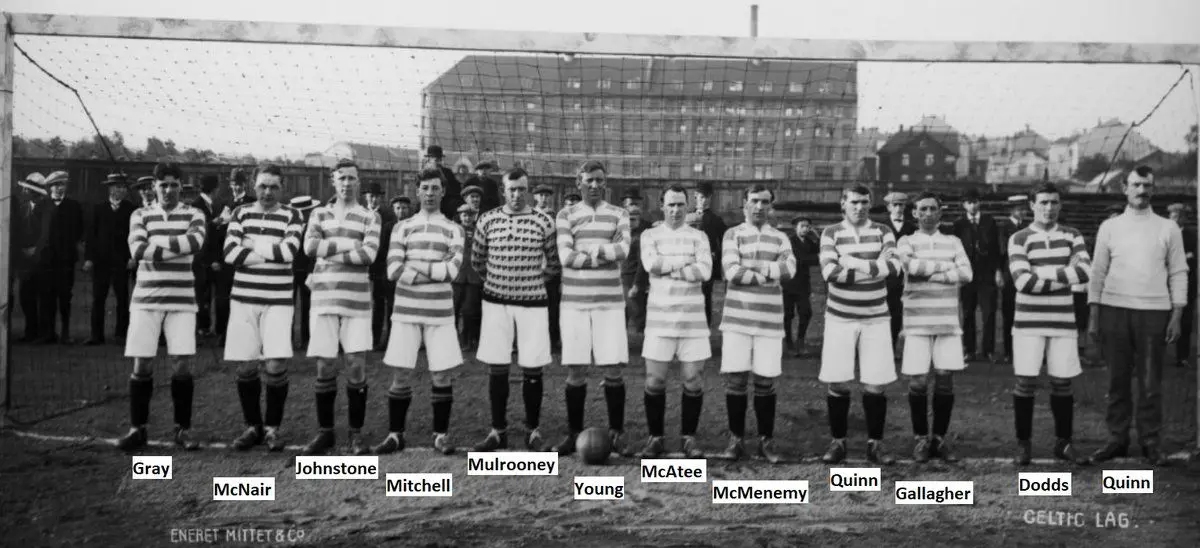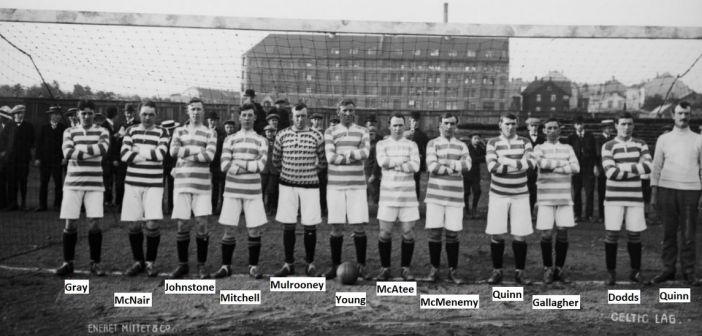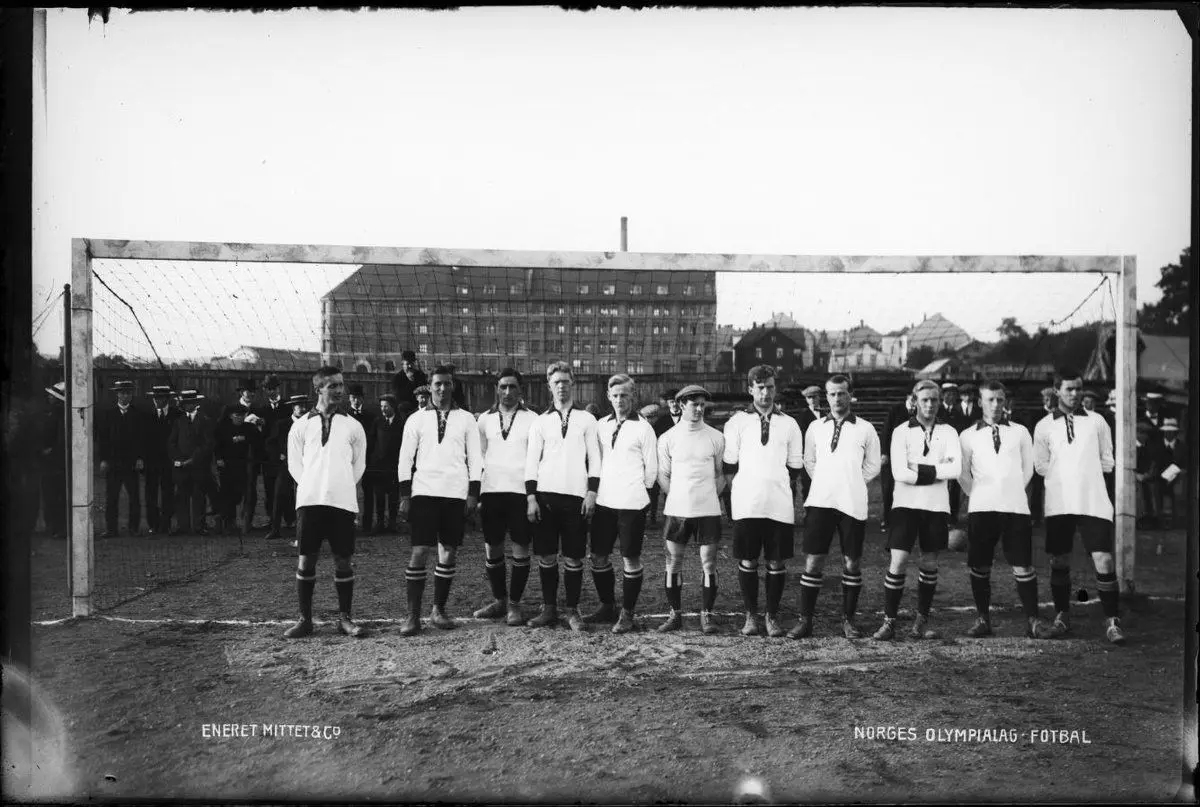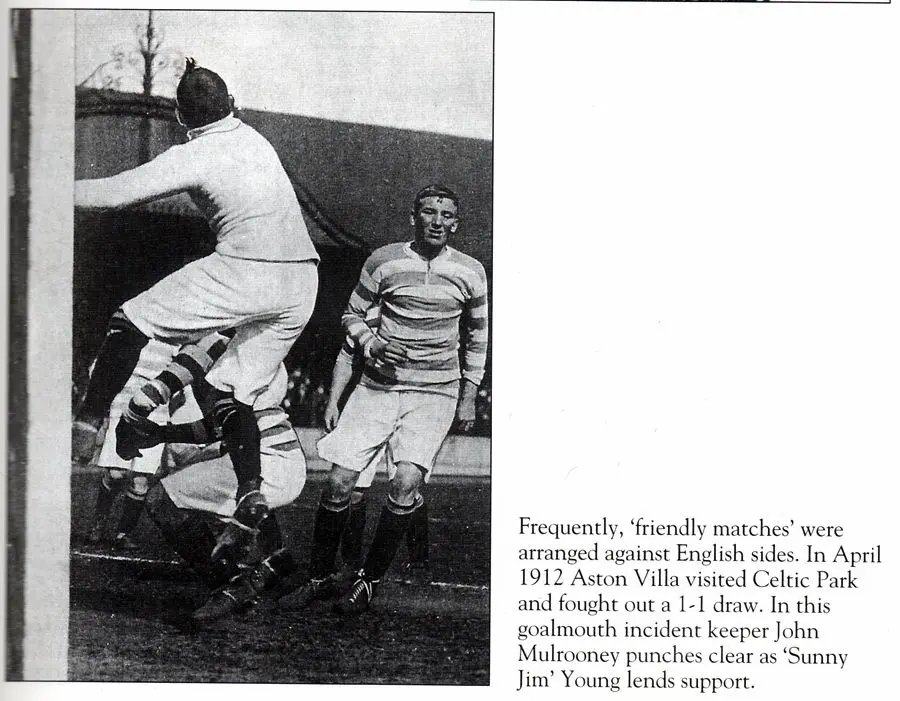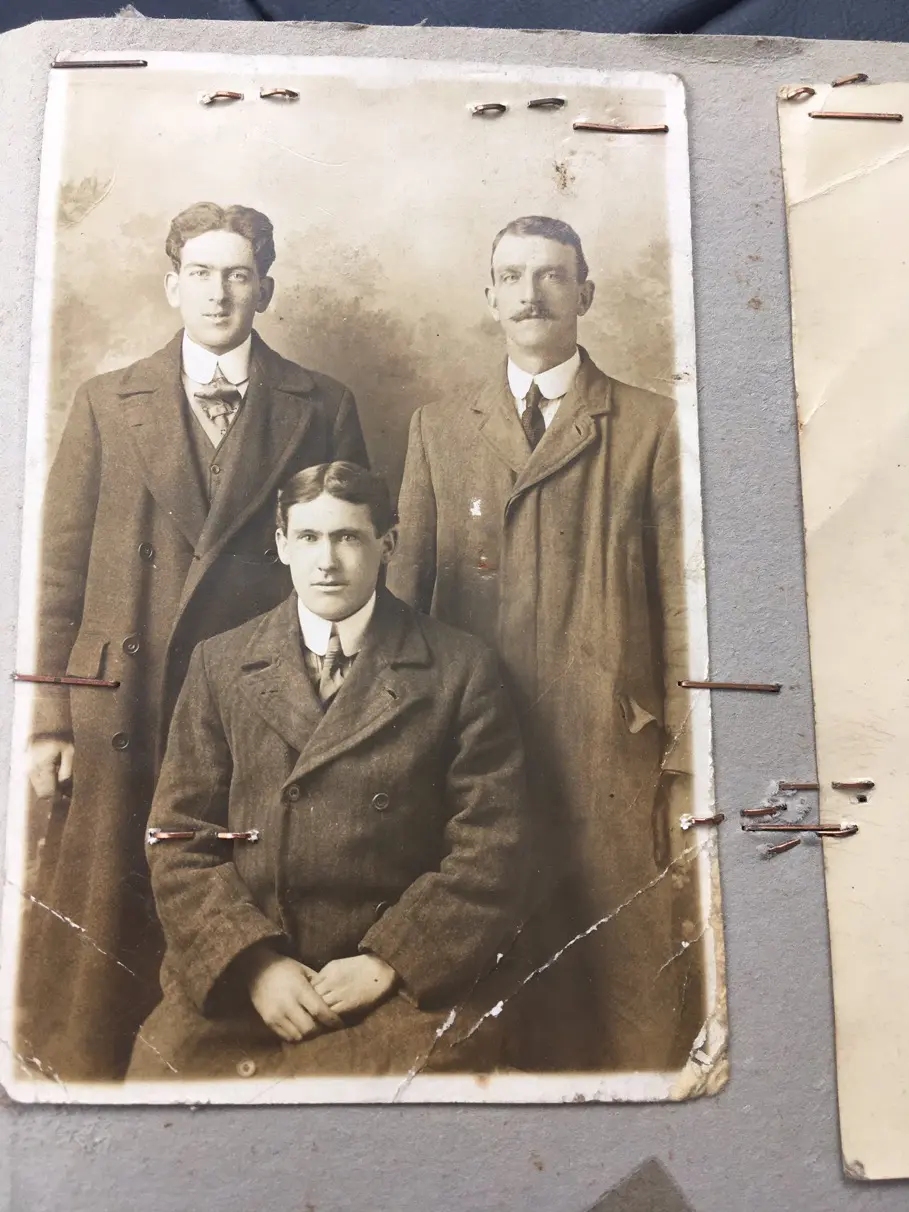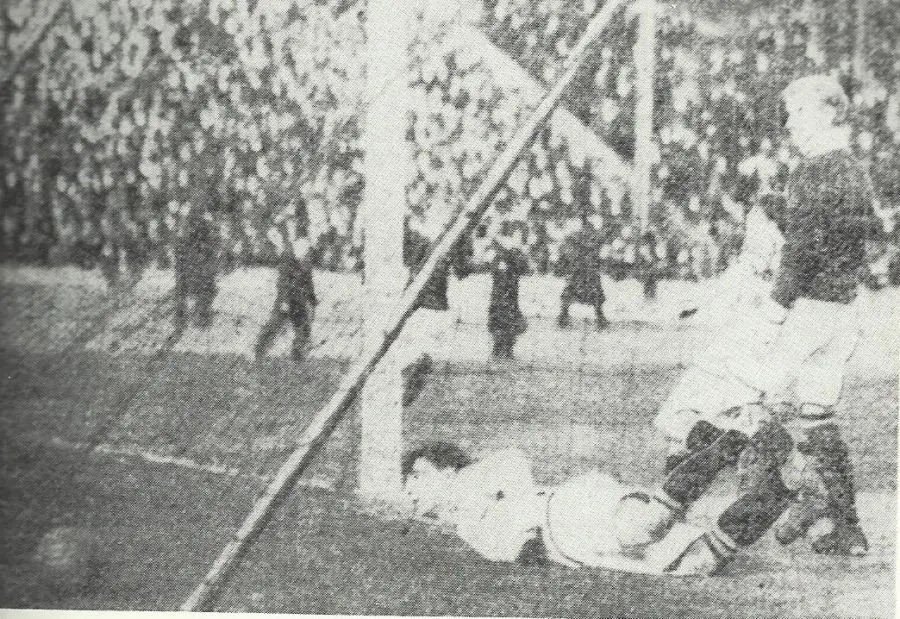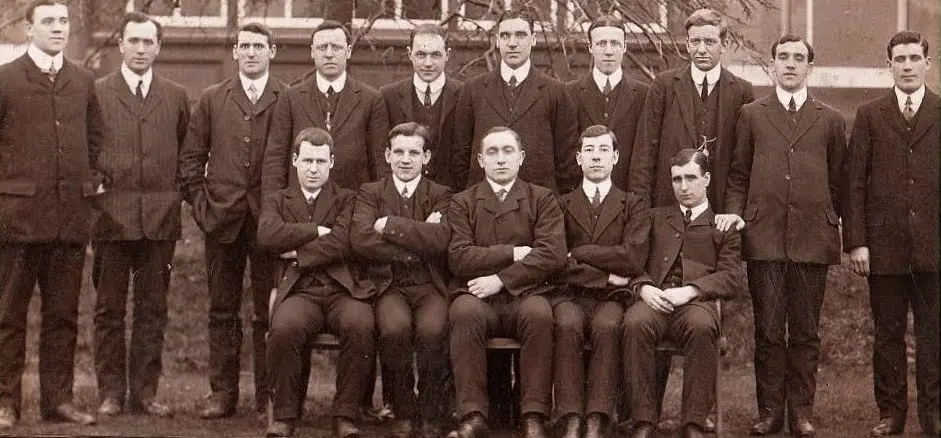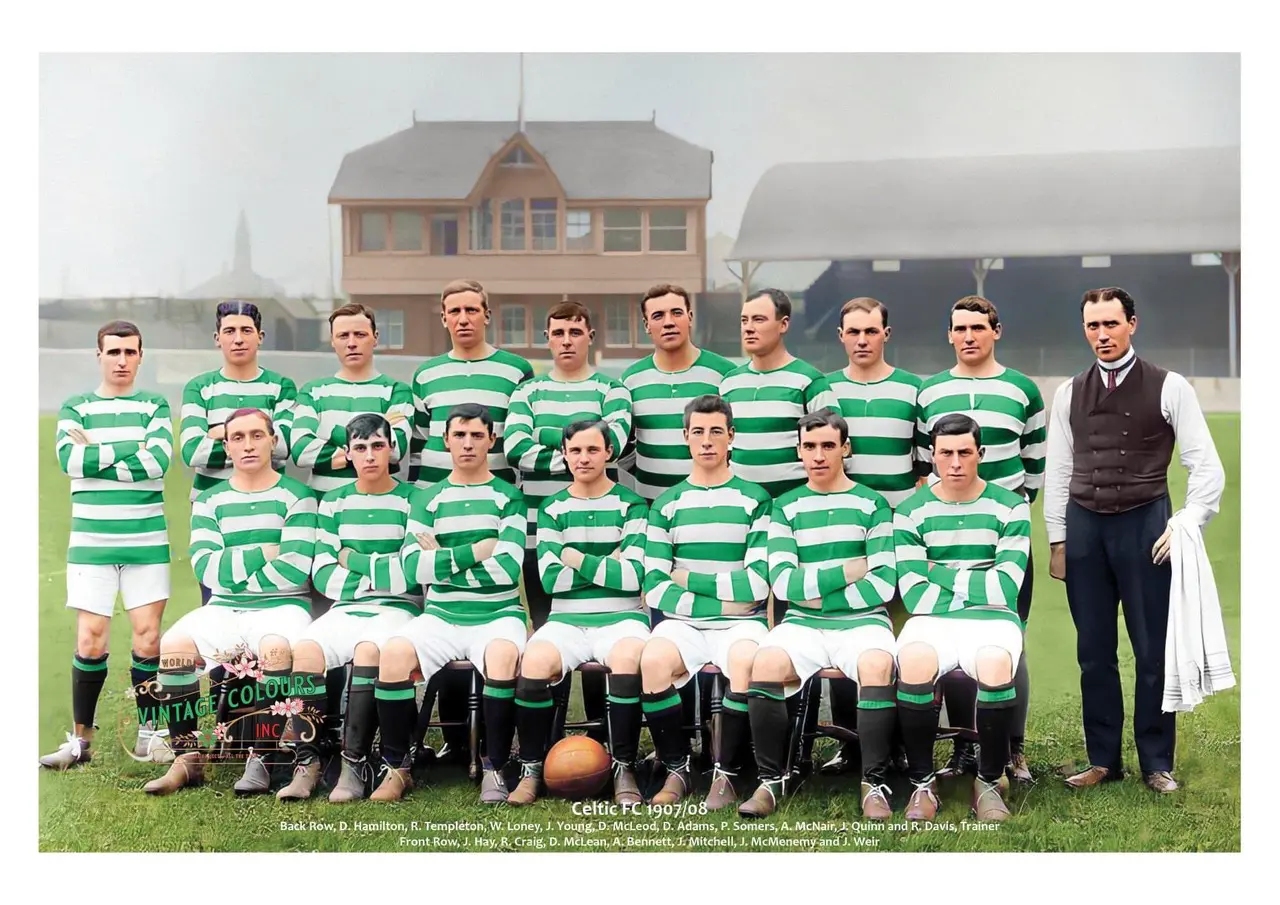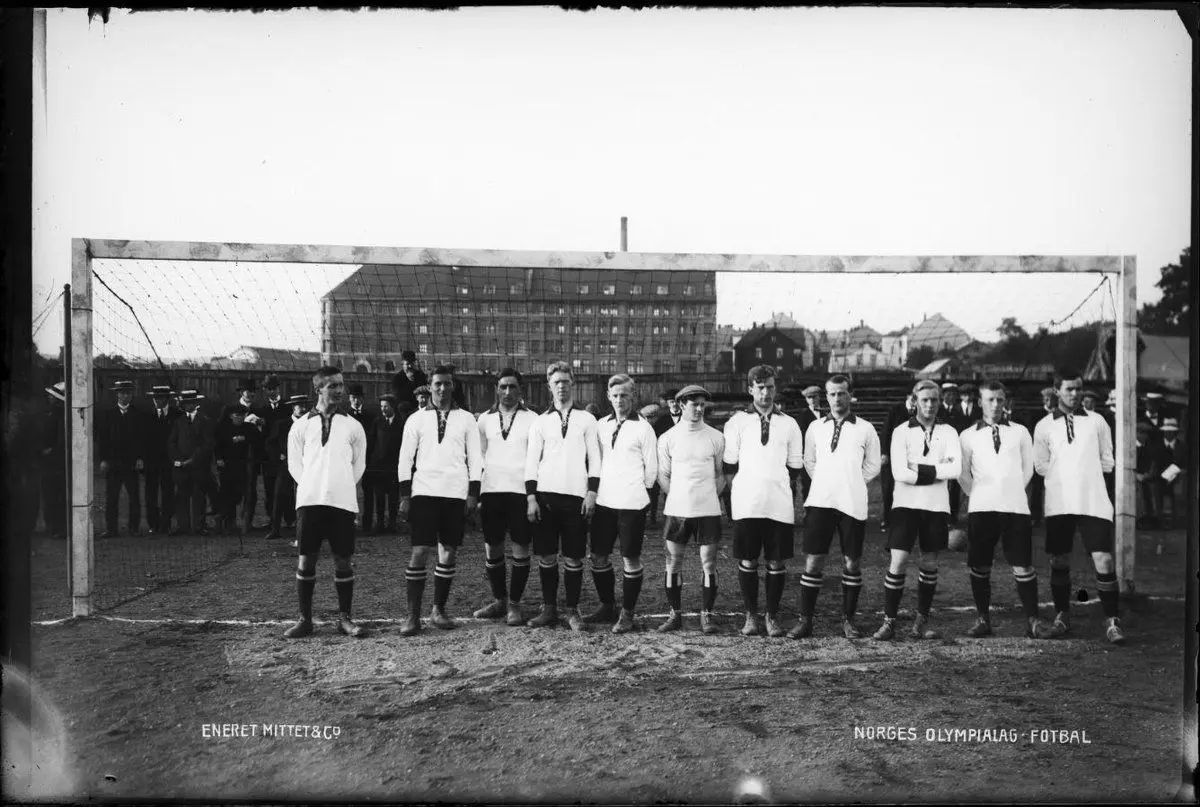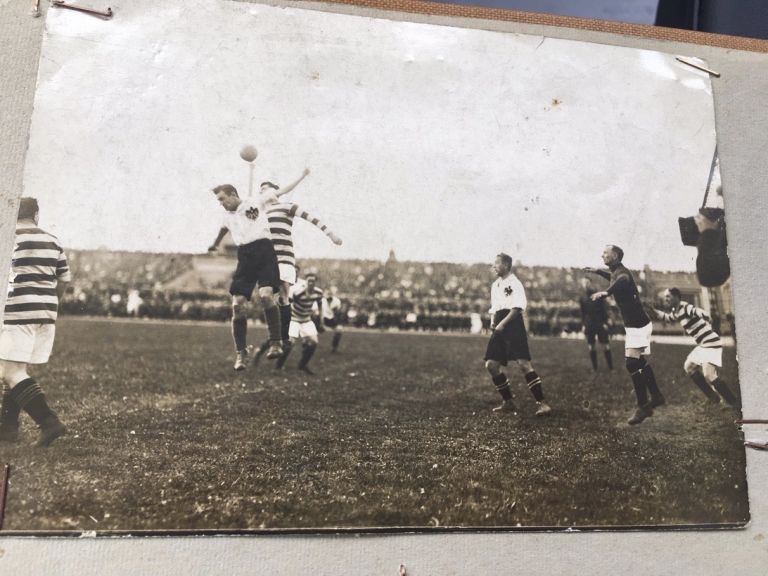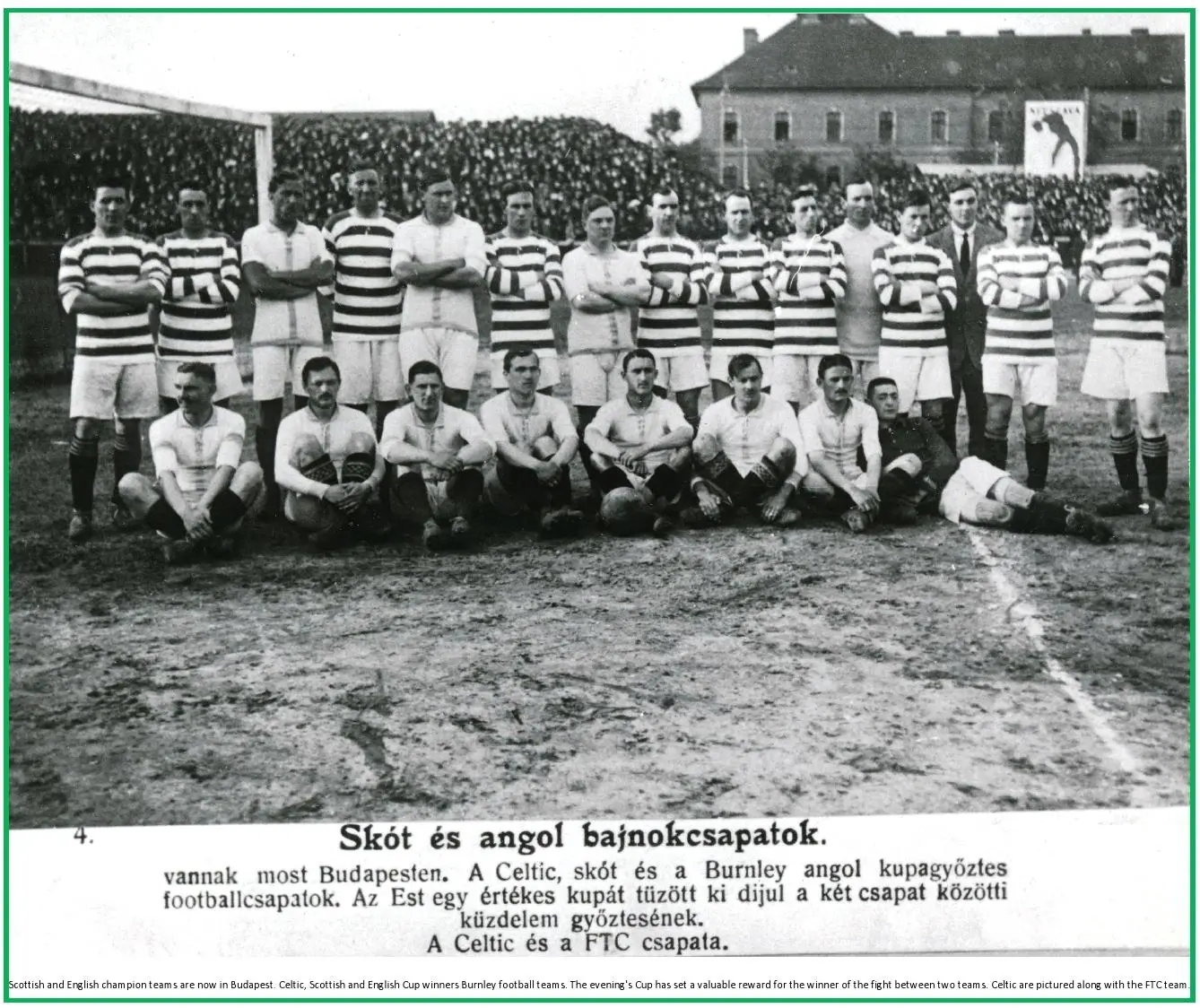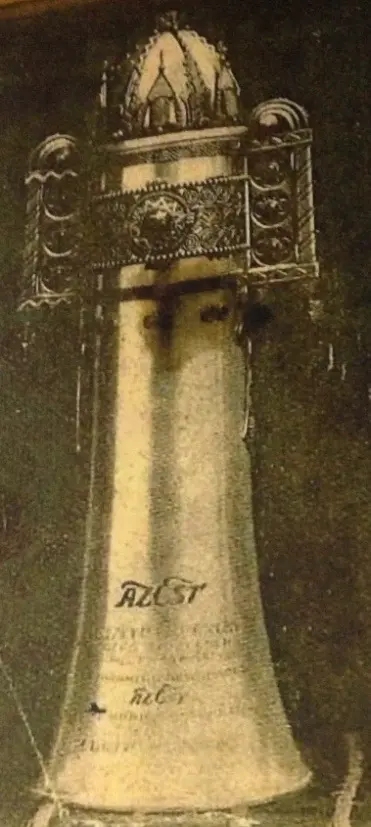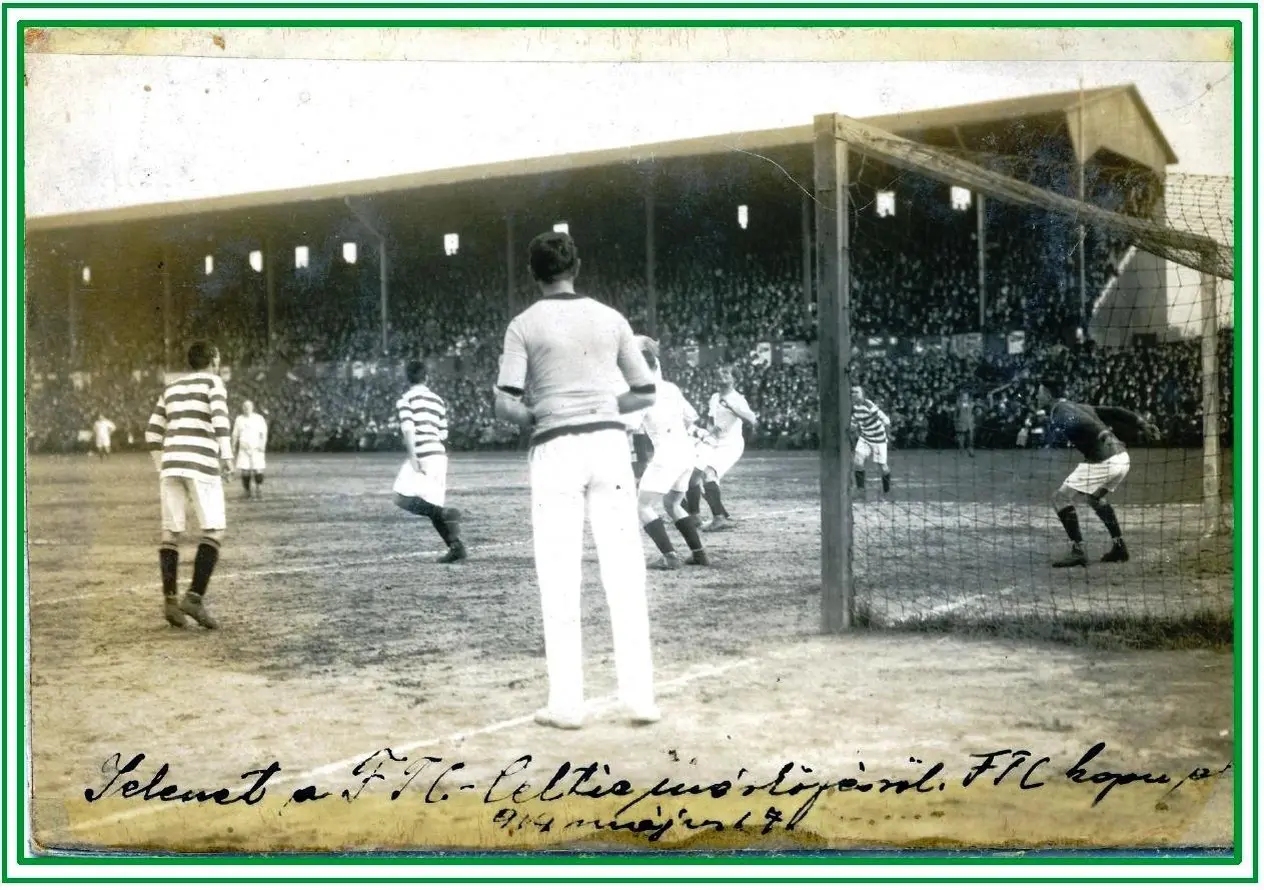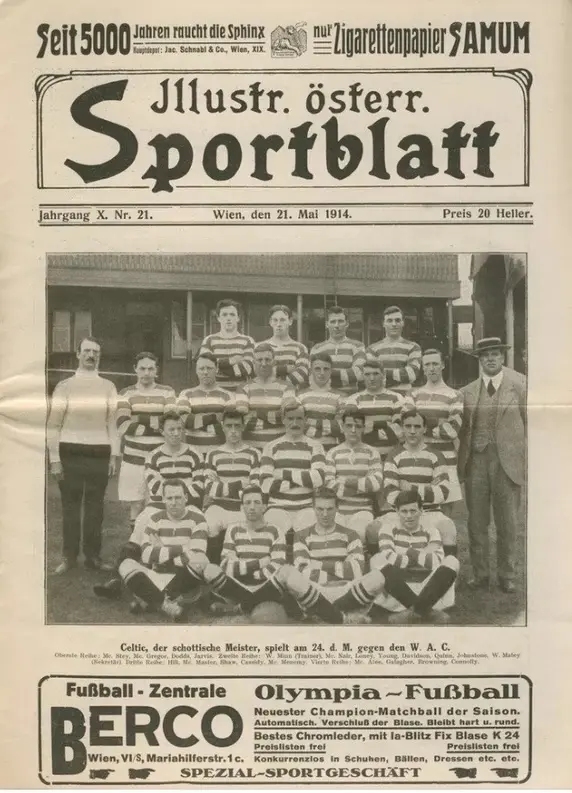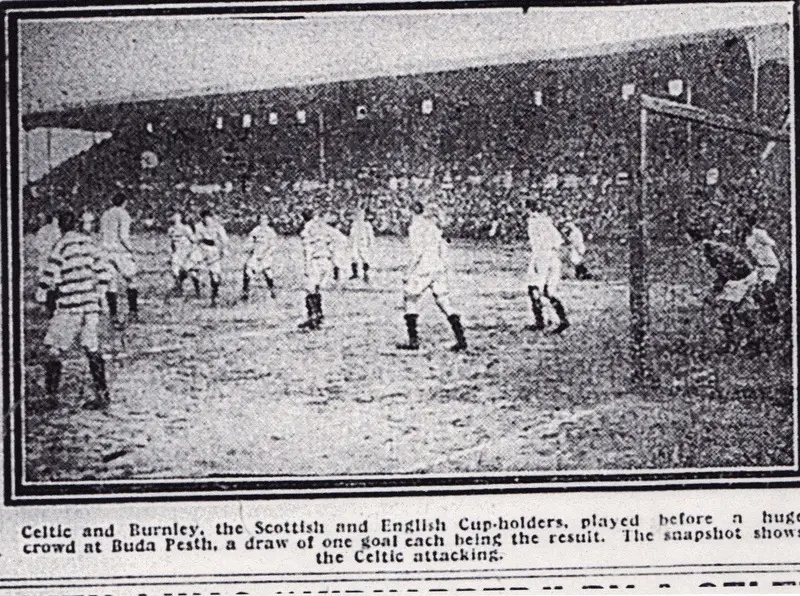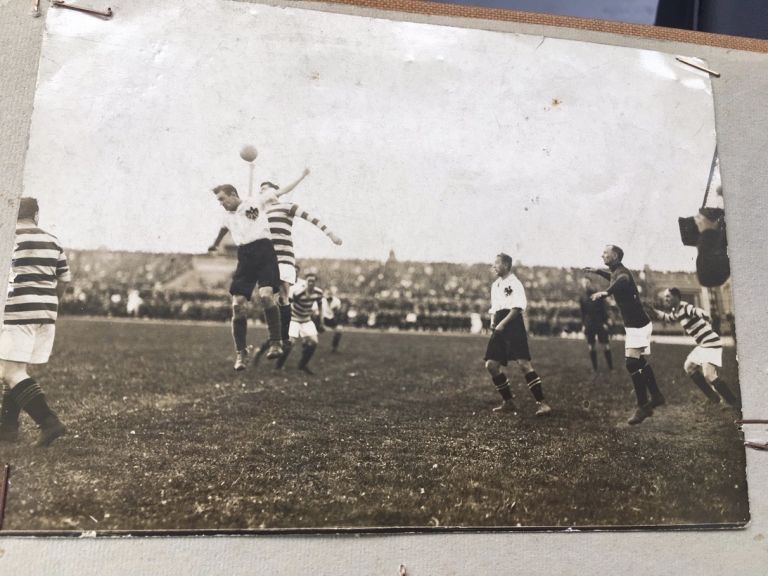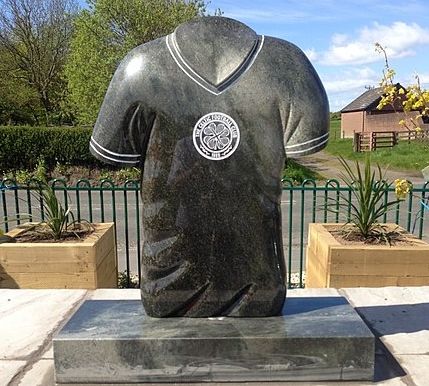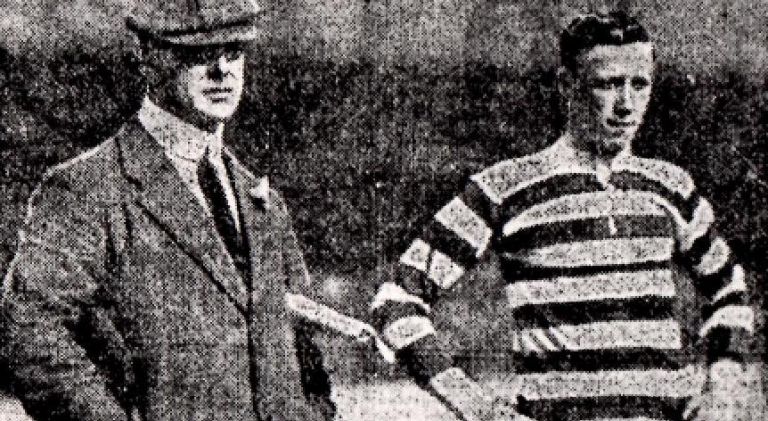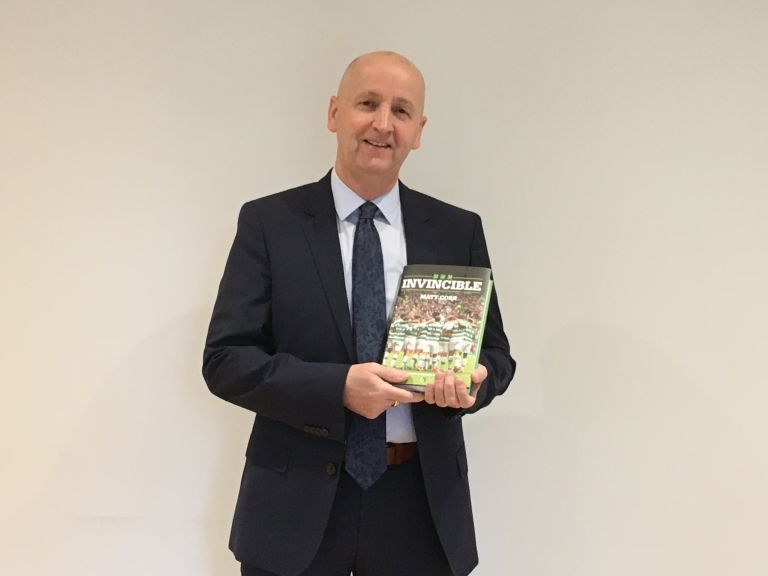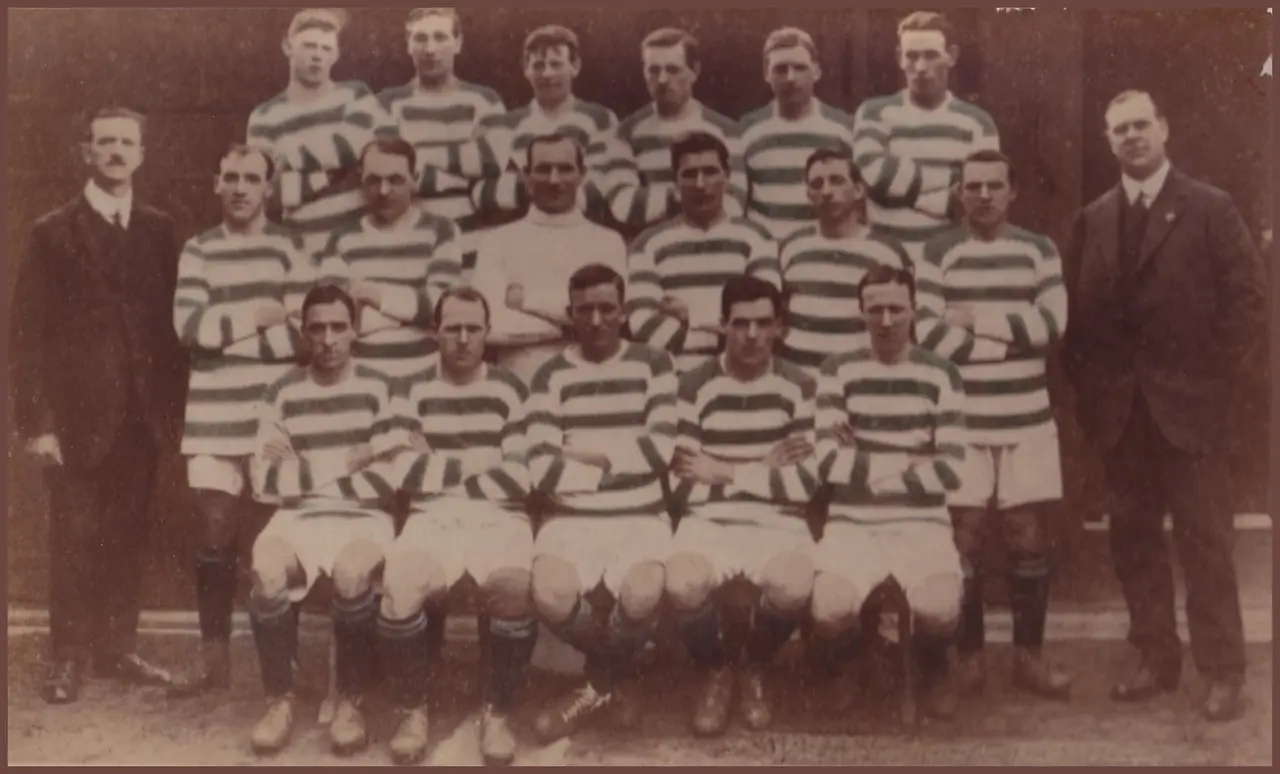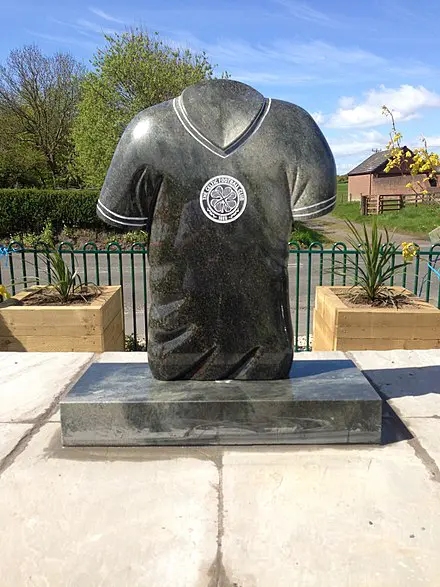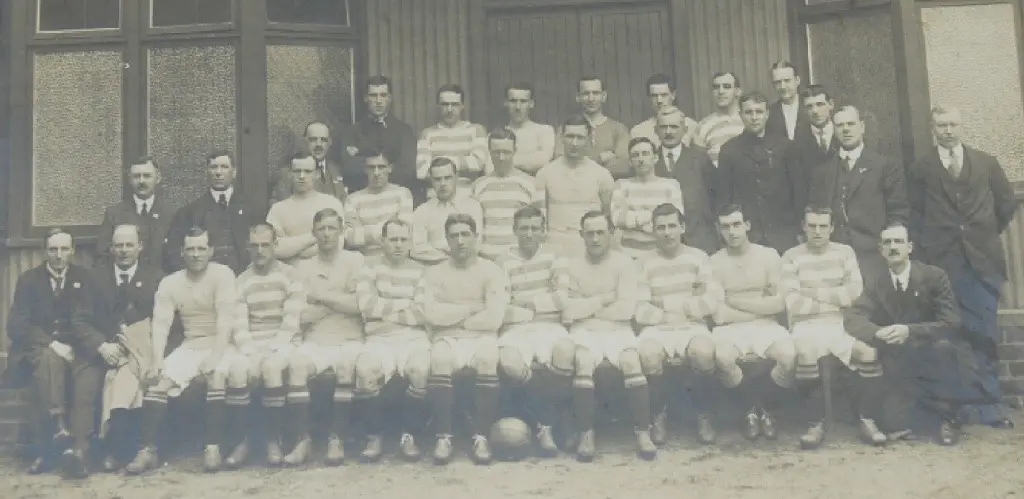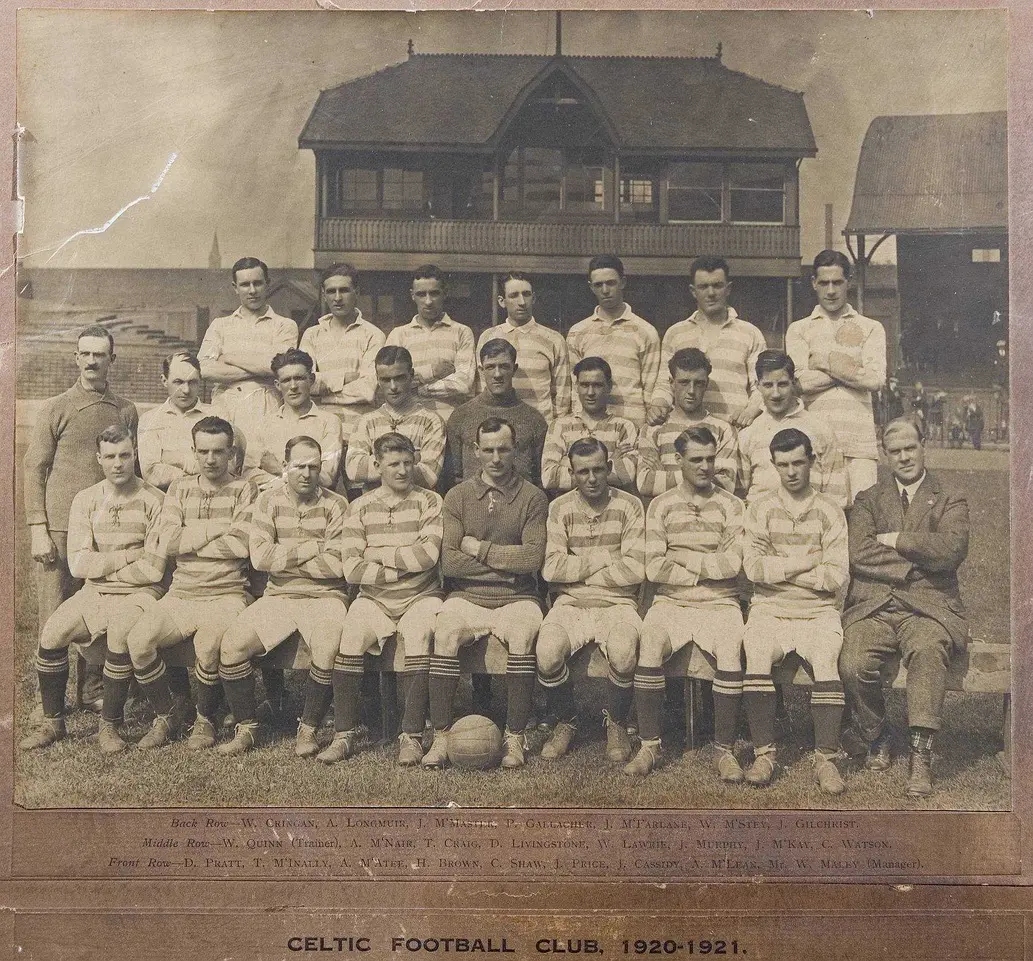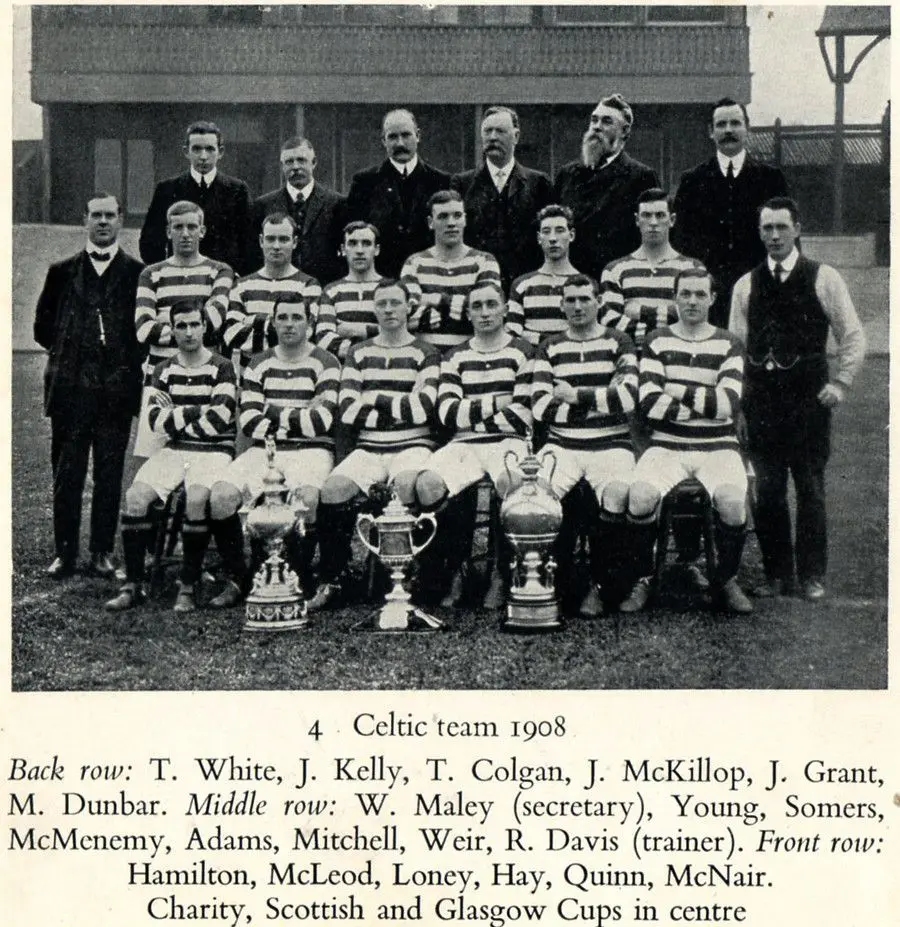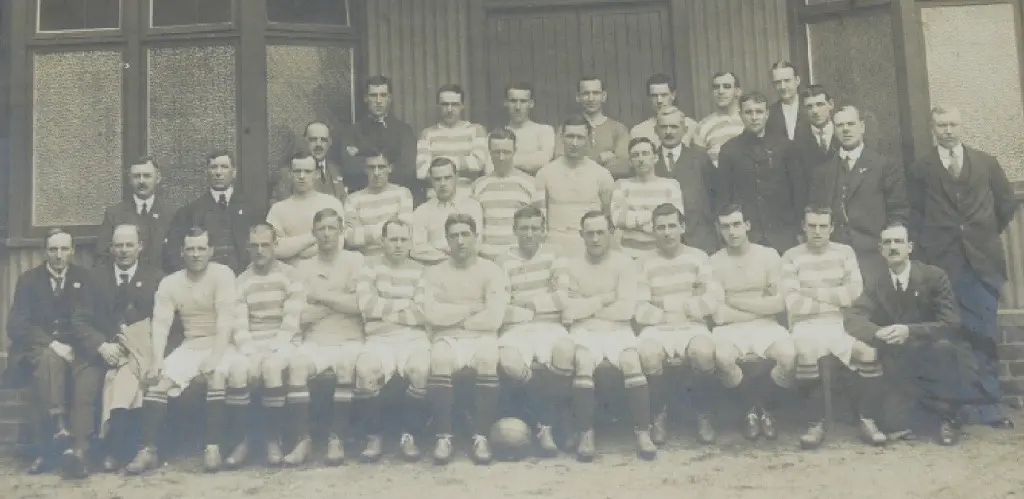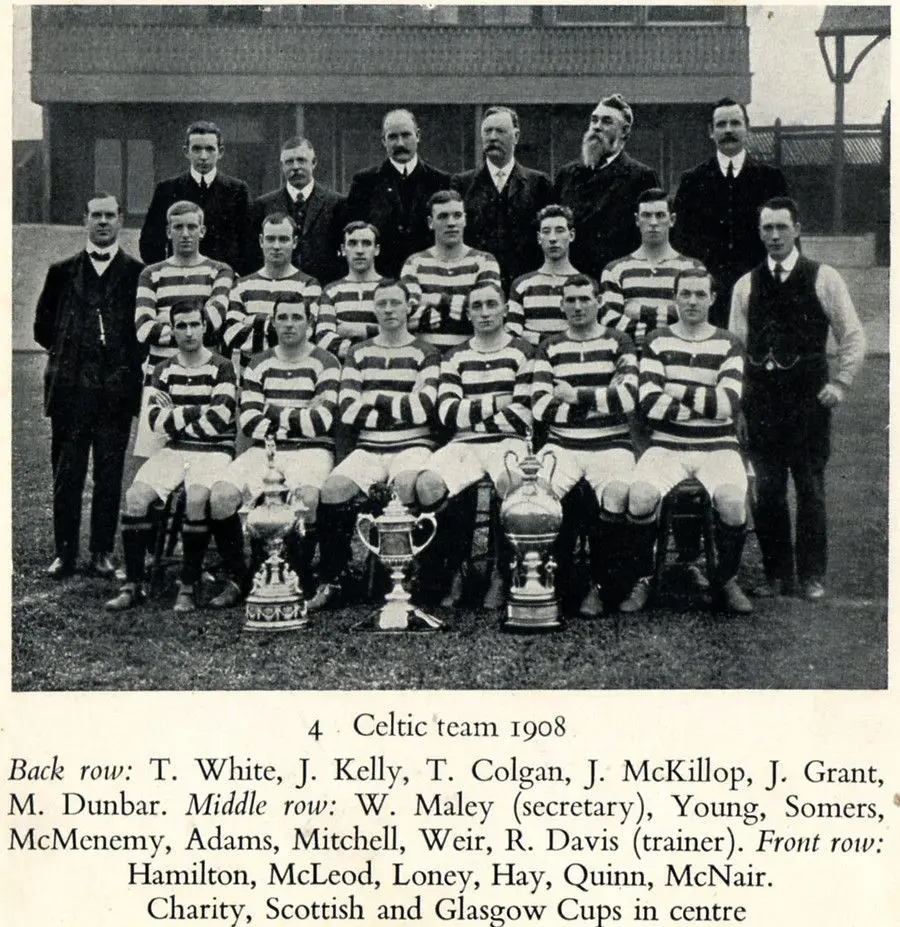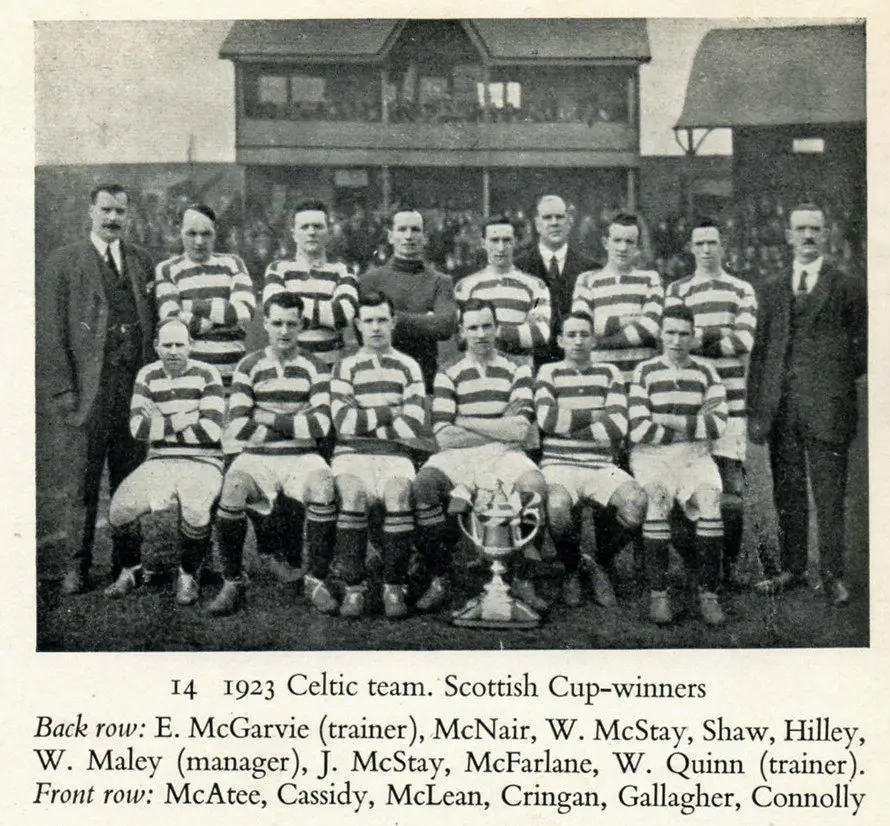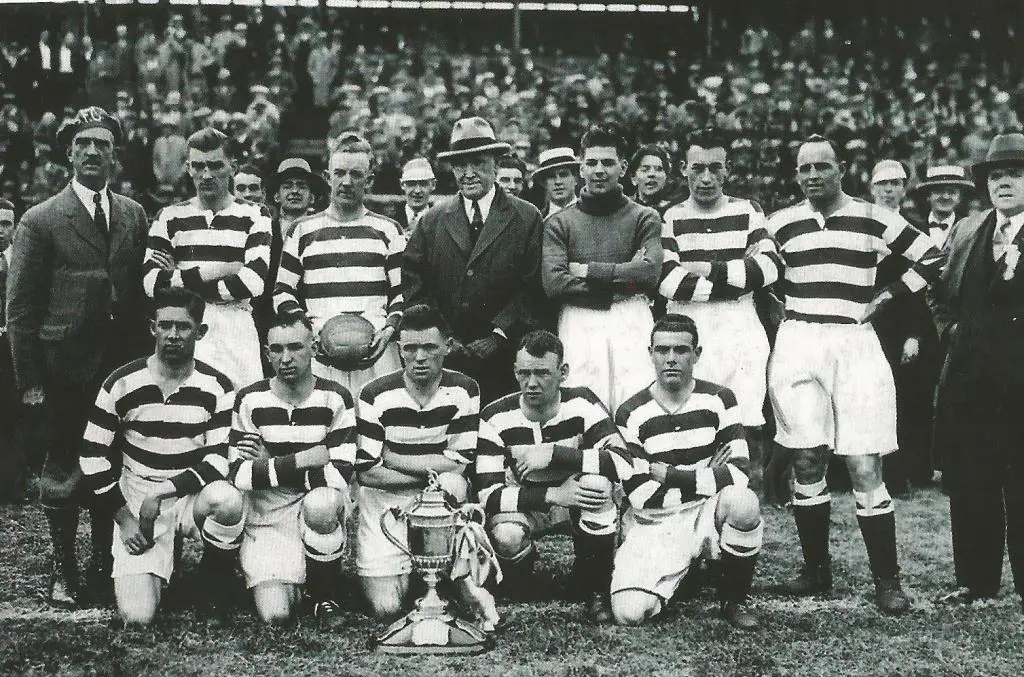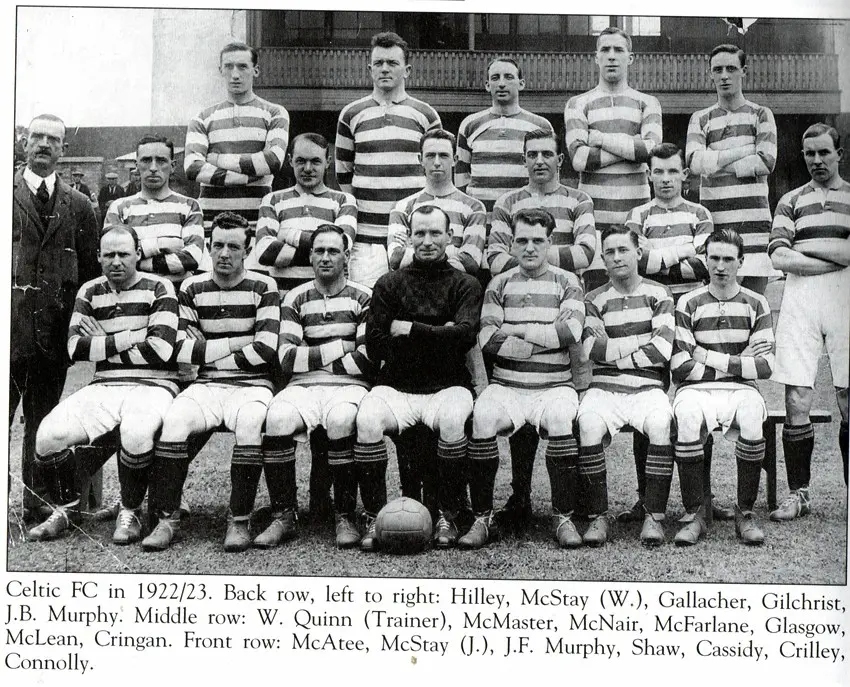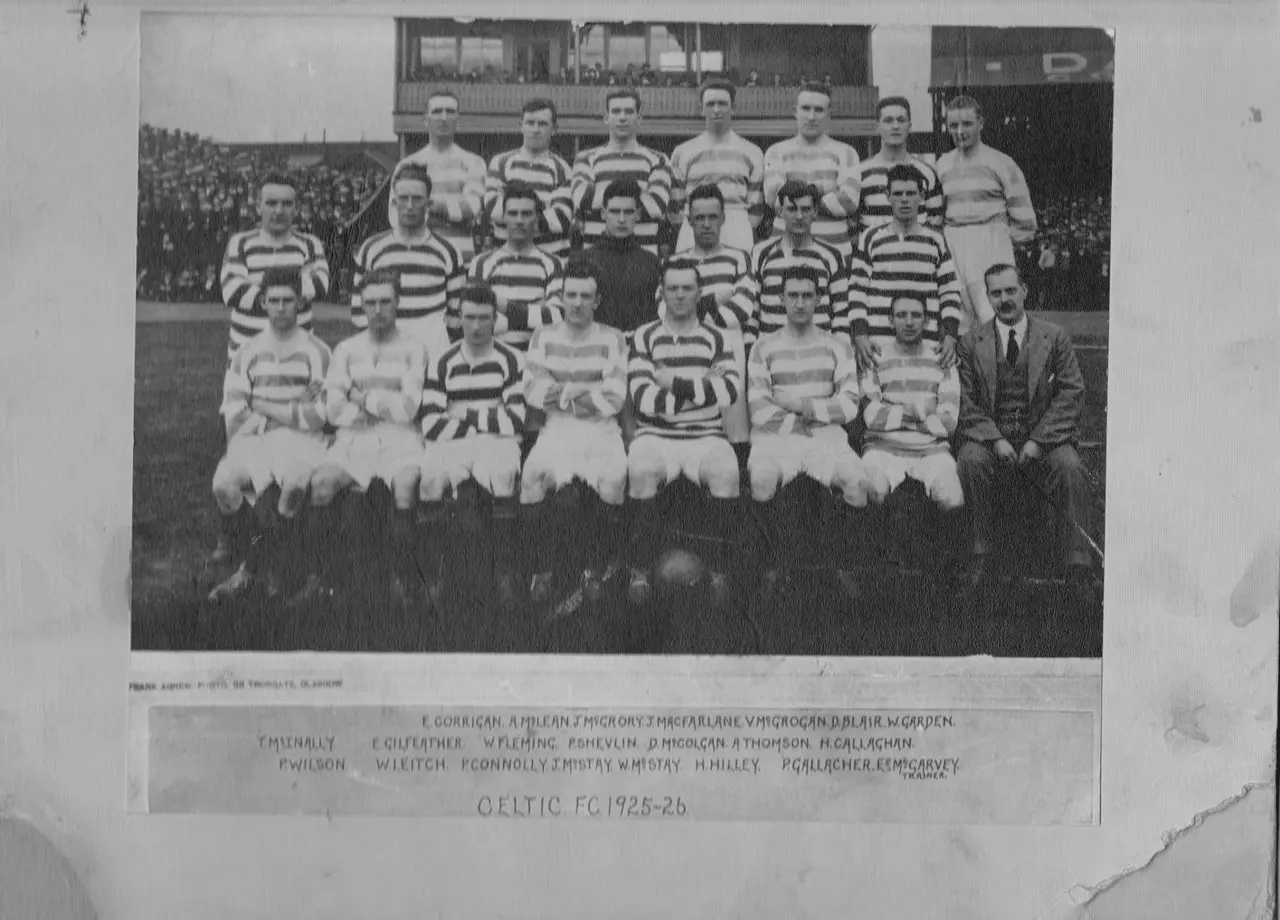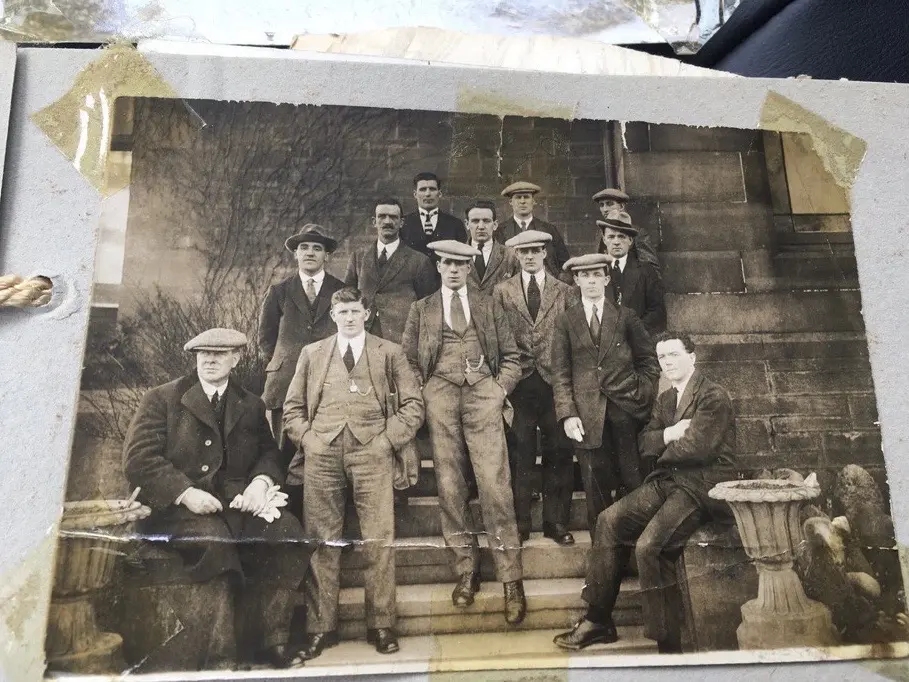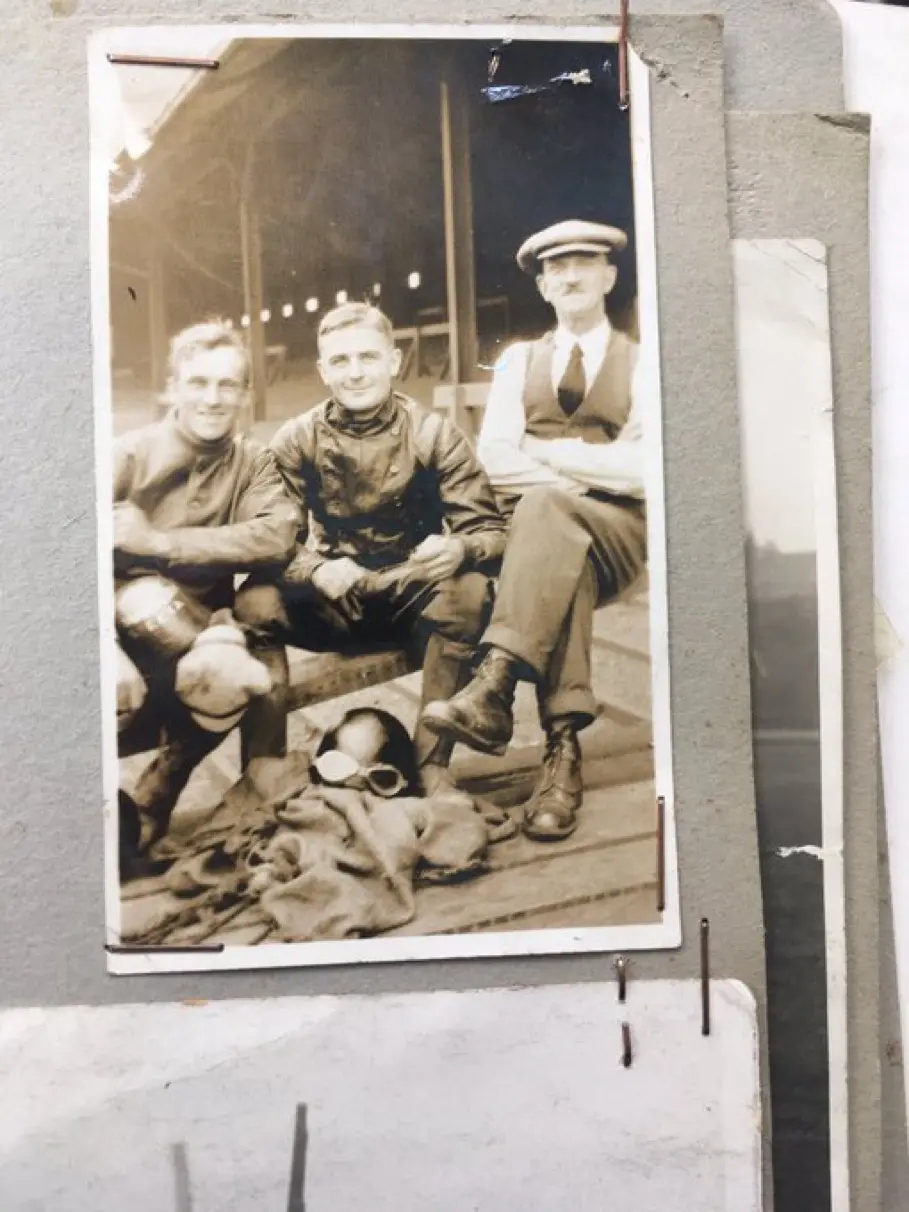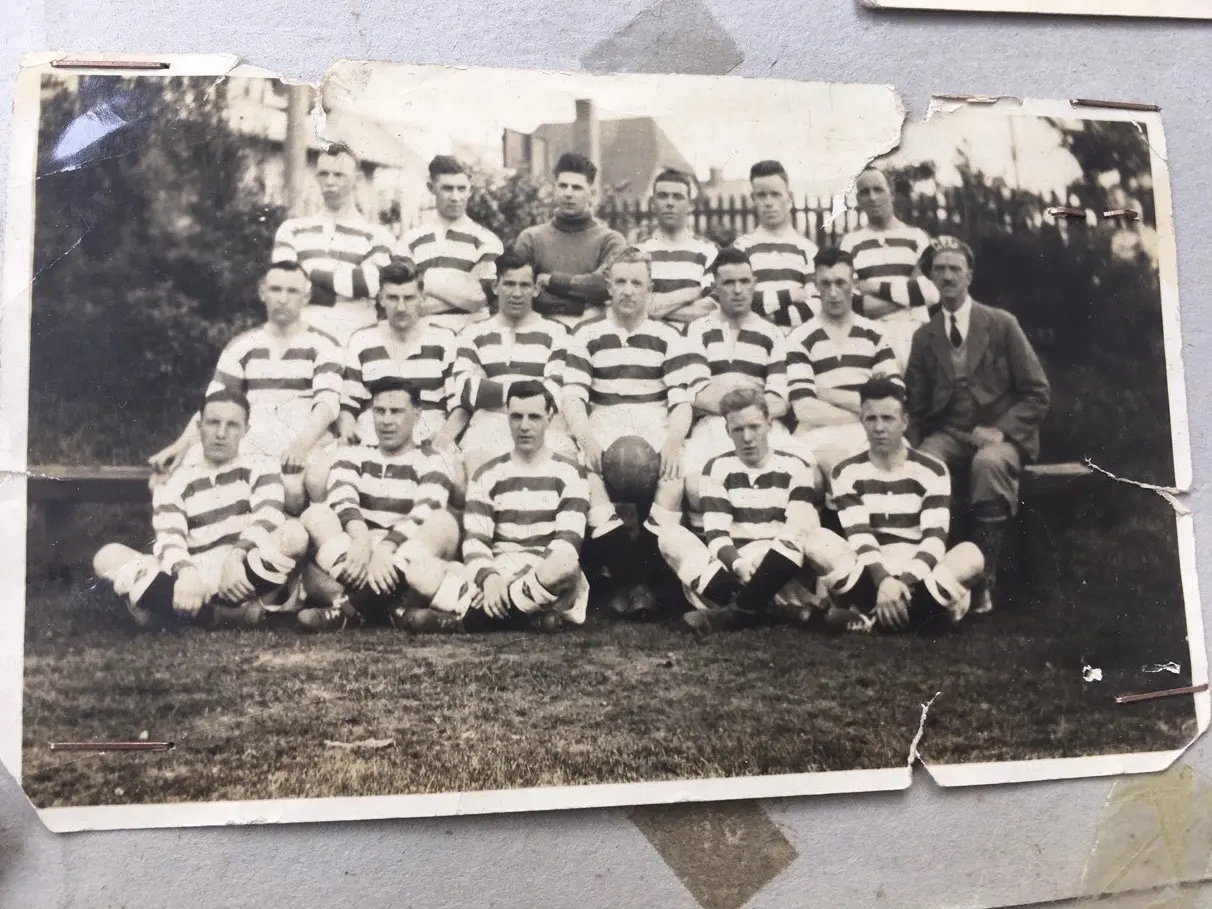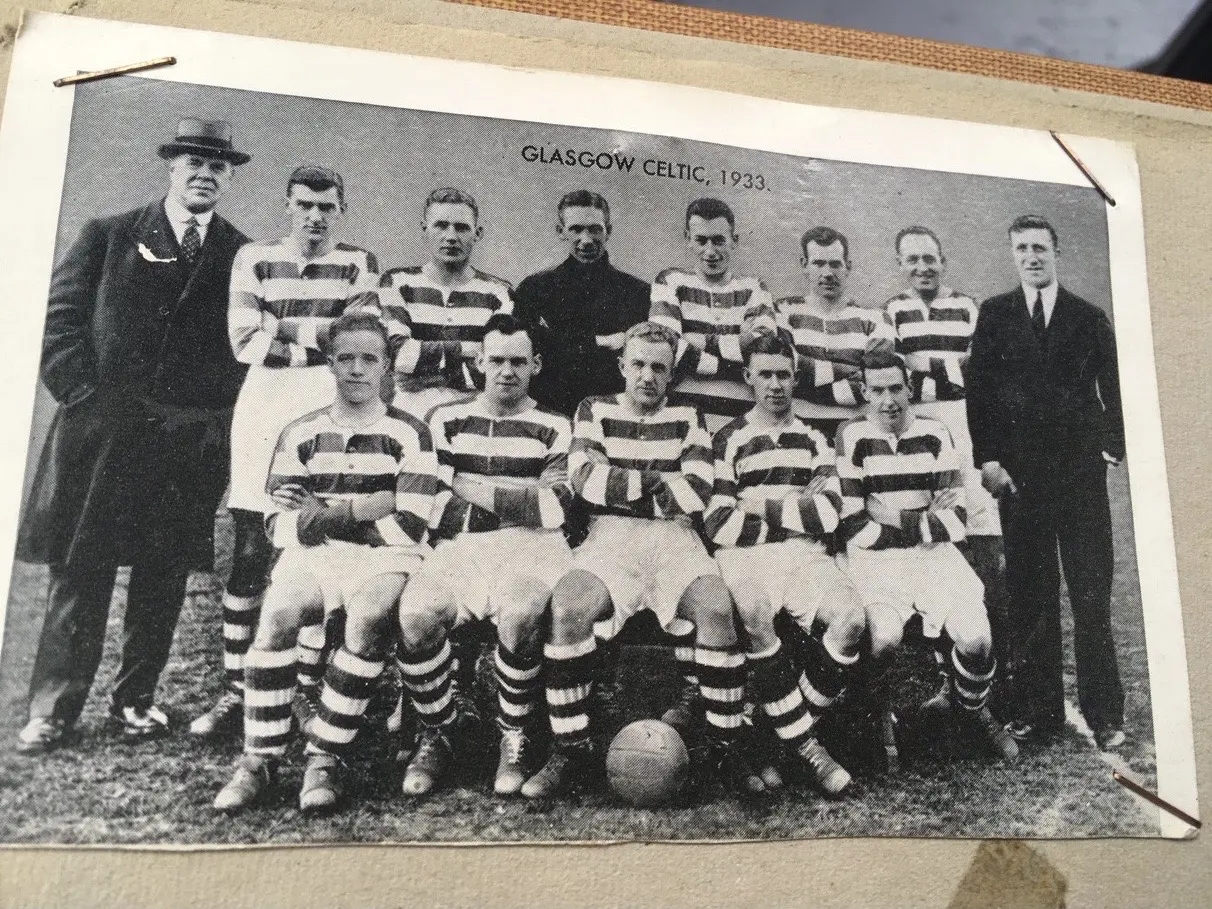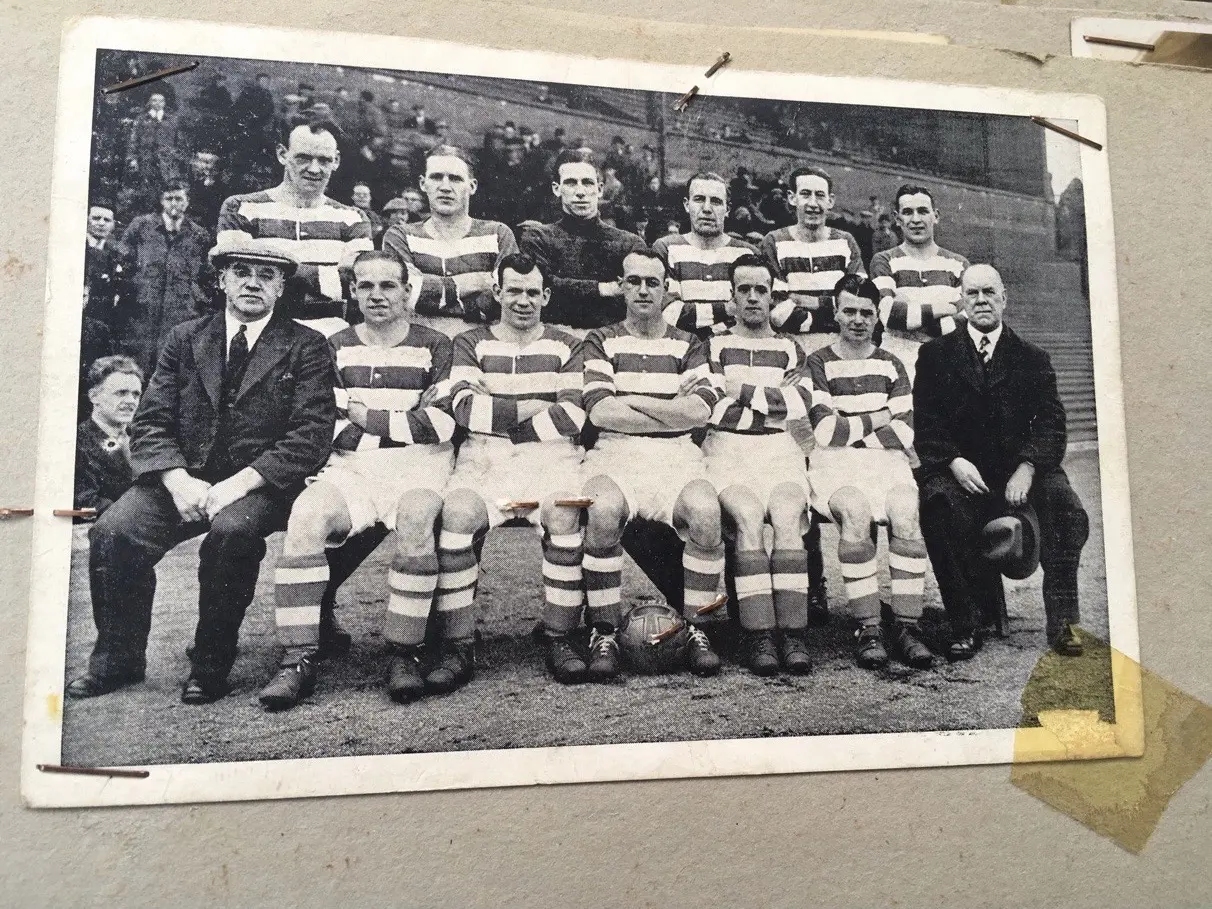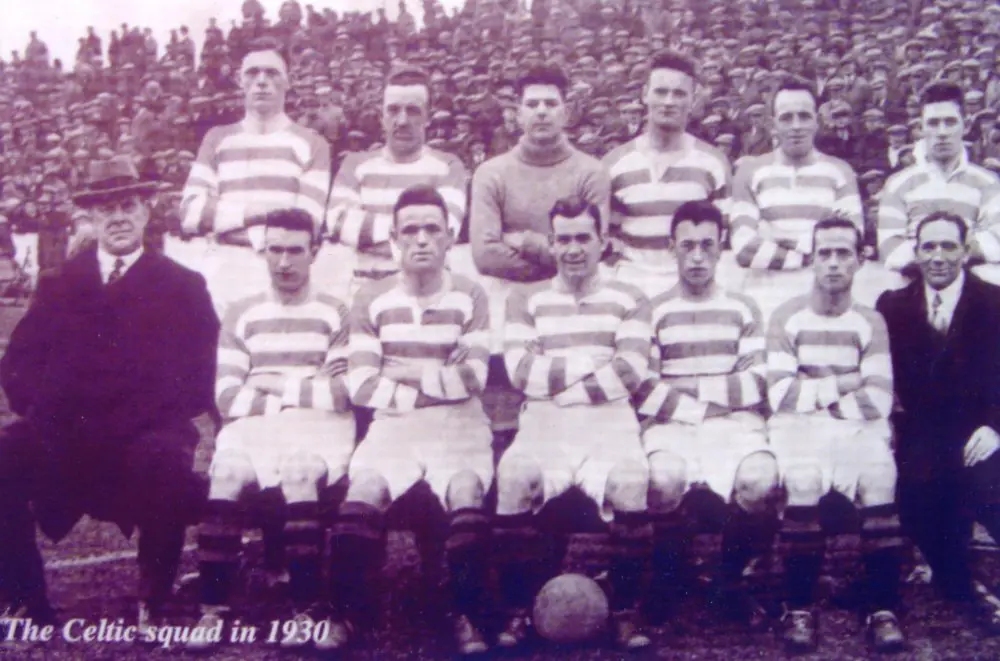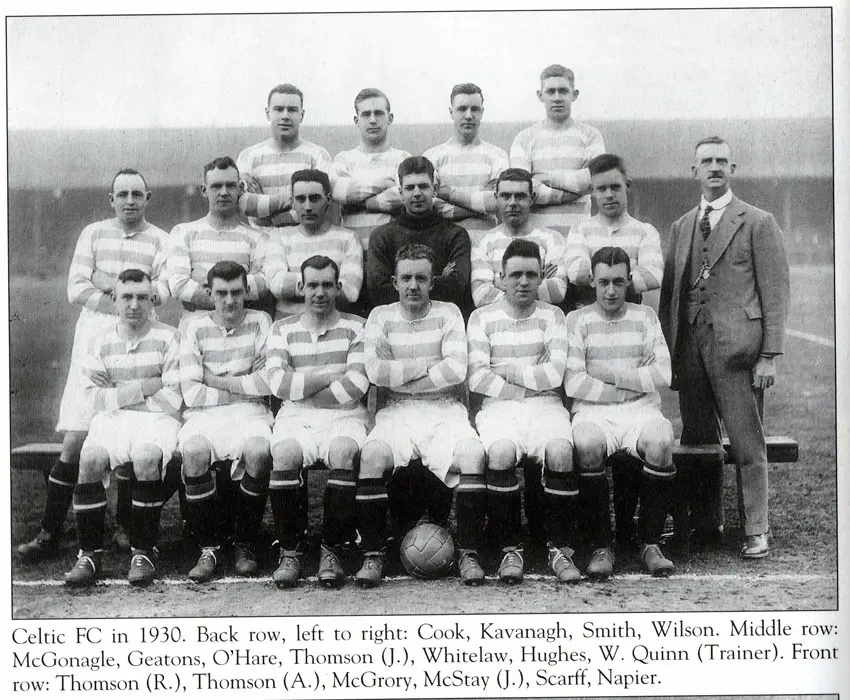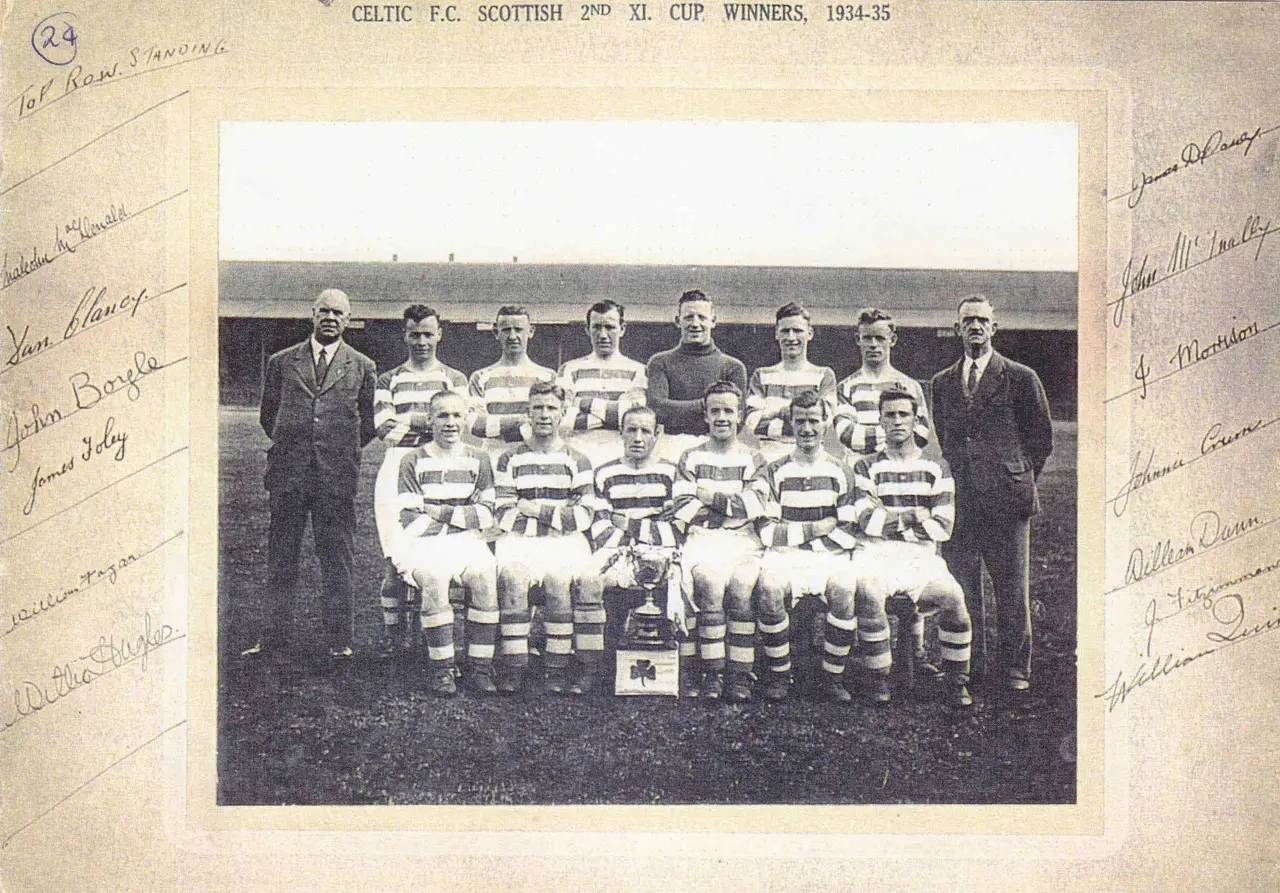Coaching and Backroom Staff – Previous
Details
Name: William Quinn
aka: Willie Quinn, Will Quinn
Role: Celtic Trainer
Tenure: 1911-1923
Source: https://www.nb.no/items/URN:NBN:no-nb_digifoto_20170405_00148_NB_MIT_ENR_02448
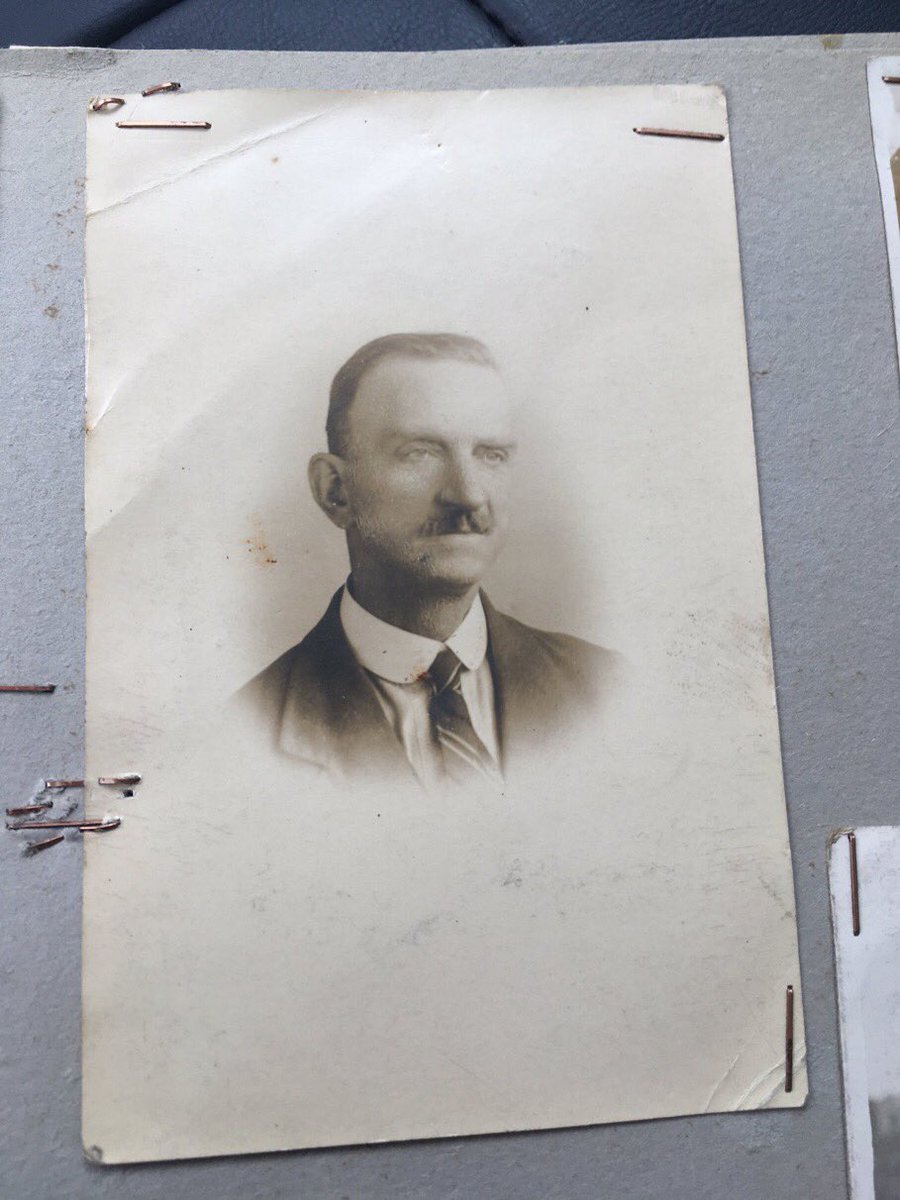
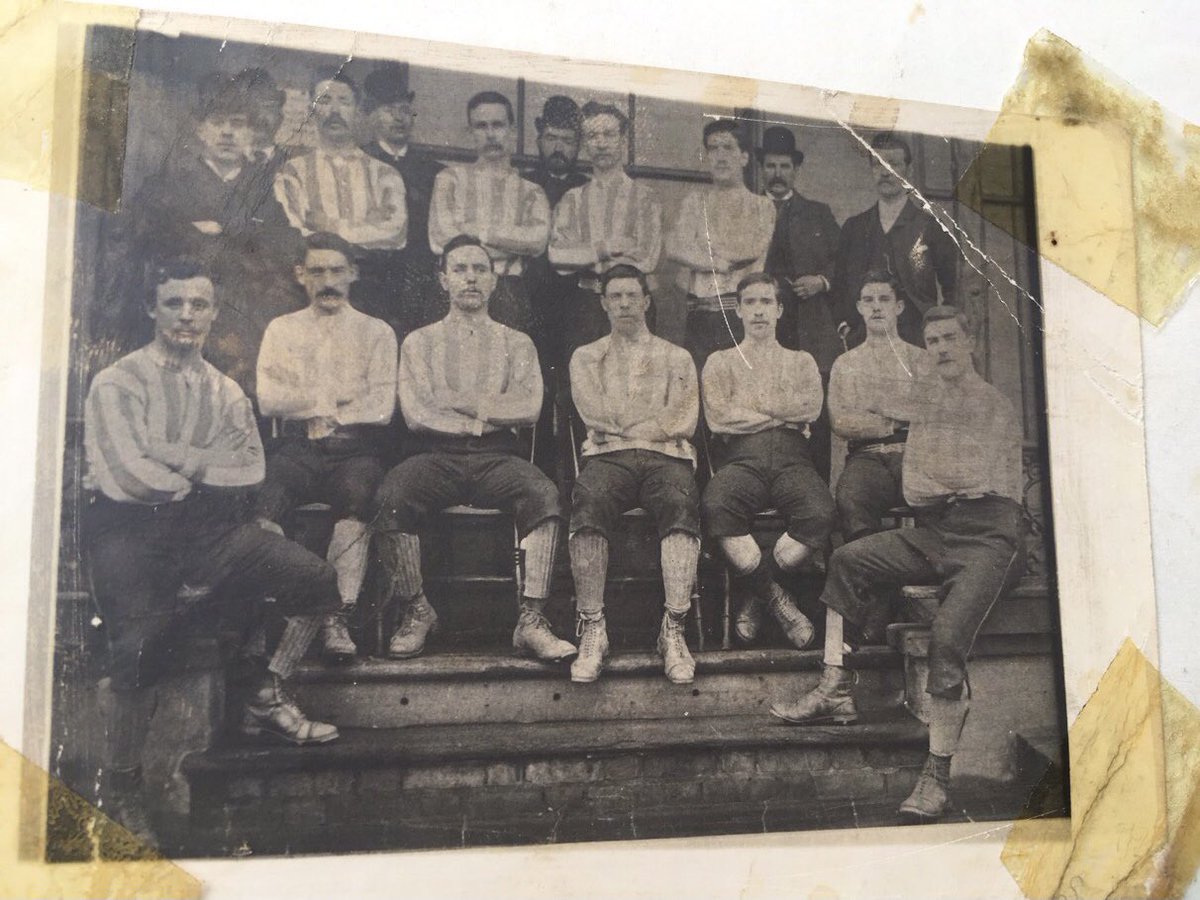
Articles
Charlie and the Bhoys: A step back in time with two unsung Celtic heroes
By Matt Corr 27 March, 2024 No Comments
[Charlie and the Bhoys: A step back in time with two unsung Celtic heroes]
Charlie and the Bhoys: A step back in time with two unsung Celtic heroes
Charlie and the Bhoys: A step back in time with two unsung Celtic heroes…
Part 1: Will Quinn – Early years in Ayrshire
Sometimes it just takes a chance conversation to unearth some real Celtic gold.
Charlie Doherty is one of the supporters who sits beside us at Celtic Park and, as you do, we have struck up a friendship over the years as we witness the many highs and occasional lows related to following our team. It is a relationship based solely on that two hours or so we spend together each time the Hoops are in action at Paradise, something echoed all around the stadium I suspect. Celtic Pals.
More months back than I care to remember – sorry, Charlie – he mentioned a photo I might be interested in seeing, and sure enough he was right. It was an image of Charlie’s grandfather – also Charlie Doherty – trying to clear the snow from the Celtic Park pitch to allow a New Year’s Day game against Rangers to go ahead, observed by a pipe-smoking Jimmy McGrory.
I immediately go into ‘statto’ mode, trying to identify the game. The Celtic End is covered, so no earlier than 1958. The Great Man is the manager, so no later than 1965. We only played that fixture at home every second year and it wouldn’t always be snowing at that time of year. The usual stuff.
Charlie then advises that his grandfather was the head groundsman at Celtic Park, and he believes he is the club’s longest-serving employee. He adds that his great-grandfather also worked for the club for many years, and that his name was Will Quinn! And that he has ‘a few other photos I’ll send on in case they are of interest to you.’
Will Quinn
Well, he did send them on, and they were of interest, to say the least. Some incredible images, which we will get to in due course.
There was clearly a story here which deserved to be told, so it duly joined the list of projects to be properly researched and written when time permitted.
It has taken a while, but here we go with the first part of Charlie and the Bhoys, a step back in time with two unsung Celtic heroes who worked for the club from the era of Maley to the tenure of Stein.
Charlie Doherty’s Great-Grandfather William Quinn was born on 21 March 1875 at George Street, St Quivox, – a village on the north-eastern outskirts of Ayr – to Michael Quinn, a Town Porter, and Rosina Quinn, nee Vance.
That very same week, Queen’s Park were engaged in a Scottish Cup semi-final struggle with Kinning Park-based outfit Clydesdale, whom they had defeated exactly 12 months earlier in the first-ever final of the competition. The 1875 last-four tie would go to three matches before Queen’s progressed to the second Scottish Cup final, where they would retain their trophy by beating Renton 3-0 at the first Hampden Park, their home ground in Crosshill, now the site of Hampden Bowling Club. We were still more than 12 years away from the formation of Celtic Football Club – which would later play such a huge part in Will’s life – in Glasgow’s east end.
We will actually begin our story around a decade earlier, as Will’s parents Michael and Rosina Quinn marry on 1 June 1866 at Trinity Chapel in Ayr, a Scottish Episcopal Church.
At that time, the Groom Michael Quinn was 38 and a Private in the 21st (Royal Scots Fusiliers) Regiment of Foot, based at Ayr Barracks, on the south side of Ayr Harbour. His parents were listed as Richard Quinn, a Forester, and Margaret Quinn, nee Mills. It is possible that they remained in Ireland after their son Michael joined the army, as he was born there. There is no sign of Richard and Margaret Quinn – Will Quinn’s paternal grandparents – in the Scottish Census records of 1841-71.
Bride Rosina Vance was 20 and a Sewer (Seamstress?), who lived at George Street, St Quivox, where her son Will would be born nine years later. Her parents were noted as James Vance, a Labourer, and Jane Vance, nee Wilson. We will duly find out that James Vance was born in Donegal and Jane Wilson in Mochrum, Wigtownshire, and that the Vance family – Will Quinn’s maternal grandparents and their children – had been living in Ayrshire since at least 1831, as a first son Joseph Vance was born there around that time.
Michael and Rosina Quinn – Will Quinn’s parents and Charlie Doherty’s Great-Great Grandparents – would be blessed with 10 children over the 24 years following their marriage in Ayr in June 1866.
We do know that they lived in Ireland around 1869 and Newport, South Wales two years later, possibly because of Michael’s army postings, as their first two children James and Mary Jane Quinn were born in those locations. But by 1873 the family are back in Ayrshire and settled in St Quivox, as a third child Michael Quinn junior is born there.
The 1881 Census (taken on 3 April 1881) shows Michael (50, a Town Porter, born in Ireland) and Rosina Quinn (33, born in Ayr) living at George Street, St Quivox, Ayr with their first six children; James Quinn (12, born in Ireland c1869), Mary Jane Quinn (10, born in Newport, South Wales 1871), Michael Quinn junior (8, born in Ayr 1873), William Quinn (6, born in Ayr on 21 March 1875), Rosina Quinn junior (3, born in Ayr 1877), Isabella Quinn (1, born in Ayr 1880) plus a lodger, Mary Gilmour, an 24-year-old Dressmaker born in Glasgow.
Note that Rosina’s parents, James and Jane Vance, are also living in George Street, St Quivox at that time, at number 100. James will pass away there a few months later, on 6 May 1881 from Cardiac Disease, aged 77. And to complete the story of Will’s maternal grandparents, Rosina’s mum Jane Vance died of a Brain Disease on 22 January 1888 at 192 Mill Street, Rutherglen, the home of her daughter Jane Neithercut. She was listed as being 74 years old.
The Quinn family would move the short distance from St Quivox to Newton-on-Ayr over the next few years and it would be there that tragedy would strike. On 9 January 1886, Will’s eight-year-old younger sister Rosina Quinn junior died of Tuberculous Meningitis at 2 Wellington Street, Newton. Will would have been just 10 years old at that time.
On leaving school, Will commenced working life as a joiner. The 1891 Census was taken on 5 April 1891, the day after a Celtic side featuring Willie Maley and Sandy McMahon lost 1-0 to St Mirren at Westmarch, Paisley in the inaugural Scottish League season. It shows his parents Michael (64, a Porter, born in Ireland) and Rosina Quinn (45, born in St Quivox, Ayr) living at 34 Wellington Street, Newton, Ayr with seven of their children; James Quinn (22, an Upholsterer, born in Ireland), William Quinn (16, a Joiner, born in St Quivox, Ayr), Bella Quinn (11, born in St Quivox, Ayr), Richard Quinn (7, born in Newton, Ayr in 1882), Joseph Quinn (5, born in Newton, Ayr 1885), John Quinn (3, born in Newton, Ayr in 1887) and Francis Quinn (7 months, born in Newton, Ayr in 1890).
Willie Maley
Sandy McMahon
Westmarch Grounds, Paisley. Home of St Mirren
Will’s elder sister Mary Jane Quinn moves into service sometime between 1881 and 1891, as in that 1891 Census she is listed as a 20-year-old Housemaid, one of four domestic servants working at Savoy, on Racecourse Road, Ayr, the home of retired soldier Norman Macdonald and his family.
Two of Mary Jane’s fellow workers, both Irish girls from Kilkenny, are significant to this story.
I believe the cook Mary Hoban (42) may be related to Minnie Hoban, a 22-year-old domestic servant who would marry Upholsterer James Quinn – Will and Mary Jane’s elder brother – that same year, on 4 June 1891 at St Margaret’s RC Church, St Quivox, Ayr.
And 27-year-old Tablemaid Catherine Dalton, known as Kate, would become the first love of Mary Jane’s teenage brother Will Quinn.
Oh, and that photo we mentioned at the start of the article?
I believe it is from January 1962 but happy to stand corrected.
To be continued…
Hail, hail!
Matt Corr
Follow Matt on Twitter/X @Boola_vogue
Charlie and the Bhoys: A step back in time with two unsung Celtic heroes
Charlie and the Bhoys: A step back in time with two unsung Celtic heroes
By Matt Corr 27 March, 2024 No Comments
[Charlie and the Bhoys: A step back in time with two unsung Celtic heroes]
Facebook
WhatsApp
Twitter
Reddit
Email
Share
Charlie and the Bhoys: A step back in time with two unsung Celtic heroes…
Part 1: Will Quinn – Early years in Ayrshire
Sometimes it just takes a chance conversation to unearth some real Celtic gold.
Charlie Doherty is one of the supporters who sits beside us at Celtic Park and, as you do, we have struck up a friendship over the years as we witness the many highs and occasional lows related to following our team. It is a relationship based solely on that two hours or so we spend together each time the Hoops are in action at Paradise, something echoed all around the stadium I suspect. Celtic Pals.
More months back than I care to remember – sorry, Charlie – he mentioned a photo I might be interested in seeing, and sure enough he was right. It was an image of Charlie’s grandfather – also Charlie Doherty – trying to clear the snow from the Celtic Park pitch to allow a New Year’s Day game against Rangers to go ahead, observed by a pipe-smoking Jimmy McGrory.
I immediately go into ‘statto’ mode, trying to identify the game. The Celtic End is covered, so no earlier than 1958. The Great Man is the manager, so no later than 1965. We only played that fixture at home every second year and it wouldn’t always be snowing at that time of year. The usual stuff.
Charlie then advises that his grandfather was the head groundsman at Celtic Park, and he believes he is the club’s longest-serving employee. He adds that his great-grandfather also worked for the club for many years, and that his name was Will Quinn! And that he has ‘a few other photos I’ll send on in case they are of interest to you.’
Will Quinn
Well, he did send them on, and they were of interest, to say the least. Some incredible images, which we will get to in due course.
There was clearly a story here which deserved to be told, so it duly joined the list of projects to be properly researched and written when time permitted.
It has taken a while, but here we go with the first part of Charlie and the Bhoys, a step back in time with two unsung Celtic heroes who worked for the club from the era of Maley to the tenure of Stein.
Charlie Doherty’s Great-Grandfather William Quinn was born on 21 March 1875 at George Street, St Quivox, – a village on the north-eastern outskirts of Ayr – to Michael Quinn, a Town Porter, and Rosina Quinn, nee Vance.
That very same week, Queen’s Park were engaged in a Scottish Cup semi-final struggle with Kinning Park-based outfit Clydesdale, whom they had defeated exactly 12 months earlier in the first-ever final of the competition. The 1875 last-four tie would go to three matches before Queen’s progressed to the second Scottish Cup final, where they would retain their trophy by beating Renton 3-0 at the first Hampden Park, their home ground in Crosshill, now the site of Hampden Bowling Club. We were still more than 12 years away from the formation of Celtic Football Club – which would later play such a huge part in Will’s life – in Glasgow’s east end.
We will actually begin our story around a decade earlier, as Will’s parents Michael and Rosina Quinn marry on 1 June 1866 at Trinity Chapel in Ayr, a Scottish Episcopal Church.
At that time, the Groom Michael Quinn was 38 and a Private in the 21st (Royal Scots Fusiliers) Regiment of Foot, based at Ayr Barracks, on the south side of Ayr Harbour. His parents were listed as Richard Quinn, a Forester, and Margaret Quinn, nee Mills. It is possible that they remained in Ireland after their son Michael joined the army, as he was born there. There is no sign of Richard and Margaret Quinn – Will Quinn’s paternal grandparents – in the Scottish Census records of 1841-71.
Bride Rosina Vance was 20 and a Sewer (Seamstress?), who lived at George Street, St Quivox, where her son Will would be born nine years later. Her parents were noted as James Vance, a Labourer, and Jane Vance, nee Wilson. We will duly find out that James Vance was born in Donegal and Jane Wilson in Mochrum, Wigtownshire, and that the Vance family – Will Quinn’s maternal grandparents and their children – had been living in Ayrshire since at least 1831, as a first son Joseph Vance was born there around that time.
Michael and Rosina Quinn – Will Quinn’s parents and Charlie Doherty’s Great-Great Grandparents – would be blessed with 10 children over the 24 years following their marriage in Ayr in June 1866.
We do know that they lived in Ireland around 1869 and Newport, South Wales two years later, possibly because of Michael’s army postings, as their first two children James and Mary Jane Quinn were born in those locations. But by 1873 the family are back in Ayrshire and settled in St Quivox, as a third child Michael Quinn junior is born there.
The 1881 Census (taken on 3 April 1881) shows Michael (50, a Town Porter, born in Ireland) and Rosina Quinn (33, born in Ayr) living at George Street, St Quivox, Ayr with their first six children; James Quinn (12, born in Ireland c1869), Mary Jane Quinn (10, born in Newport, South Wales 1871), Michael Quinn junior (8, born in Ayr 1873), William Quinn (6, born in Ayr on 21 March 1875), Rosina Quinn junior (3, born in Ayr 1877), Isabella Quinn (1, born in Ayr 1880) plus a lodger, Mary Gilmour, an 24-year-old Dressmaker born in Glasgow.
Note that Rosina’s parents, James and Jane Vance, are also living in George Street, St Quivox at that time, at number 100. James will pass away there a few months later, on 6 May 1881 from Cardiac Disease, aged 77. And to complete the story of Will’s maternal grandparents, Rosina’s mum Jane Vance died of a Brain Disease on 22 January 1888 at 192 Mill Street, Rutherglen, the home of her daughter Jane Neithercut. She was listed as being 74 years old.
The Quinn family would move the short distance from St Quivox to Newton-on-Ayr over the next few years and it would be there that tragedy would strike. On 9 January 1886, Will’s eight-year-old younger sister Rosina Quinn junior died of Tuberculous Meningitis at 2 Wellington Street, Newton. Will would have been just 10 years old at that time.
On leaving school, Will commenced working life as a joiner. The 1891 Census was taken on 5 April 1891, the day after a Celtic side featuring Willie Maley and Sandy McMahon lost 1-0 to St Mirren at Westmarch, Paisley in the inaugural Scottish League season. It shows his parents Michael (64, a Porter, born in Ireland) and Rosina Quinn (45, born in St Quivox, Ayr) living at 34 Wellington Street, Newton, Ayr with seven of their children; James Quinn (22, an Upholsterer, born in Ireland), William Quinn (16, a Joiner, born in St Quivox, Ayr), Bella Quinn (11, born in St Quivox, Ayr), Richard Quinn (7, born in Newton, Ayr in 1882), Joseph Quinn (5, born in Newton, Ayr 1885), John Quinn (3, born in Newton, Ayr in 1887) and Francis Quinn (7 months, born in Newton, Ayr in 1890).
Willie Maley
Sandy McMahon
Westmarch Grounds, Paisley. Home of St Mirren
Will’s elder sister Mary Jane Quinn moves into service sometime between 1881 and 1891, as in that 1891 Census she is listed as a 20-year-old Housemaid, one of four domestic servants working at Savoy, on Racecourse Road, Ayr, the home of retired soldier Norman Macdonald and his family.
Two of Mary Jane’s fellow workers, both Irish girls from Kilkenny, are significant to this story.
I believe the cook Mary Hoban (42) may be related to Minnie Hoban, a 22-year-old domestic servant who would marry Upholsterer James Quinn – Will and Mary Jane’s elder brother – that same year, on 4 June 1891 at St Margaret’s RC Church, St Quivox, Ayr.
And 27-year-old Tablemaid Catherine Dalton, known as Kate, would become the first love of Mary Jane’s teenage brother Will Quinn.
Oh, and that photo we mentioned at the start of the article?
I believe it is from January 1962 but happy to stand corrected.
To be continued…
Hail, hail!
Matt Corr
Follow Matt on Twitter/X @Boola_vogue
Charlie and the Bhoys: Two weddings and three funerals
By Matt Corr 28 March, 2024 No Comments
[Charlie and the Bhoys: Two weddings and three funerals]
Facebook
WhatsApp
Twitter
Reddit
Email
Share
Charlie and the Bhoys: A step back in time with two unsung Celtic heroes
Part 2: Two weddings and three funerals for the young Will Quinn
The 1901 Census was taken on 31 March 1901, as Willie Maley’s Celtic prepared for the Scottish Cup final against Hearts at Ibrox the following weekend, the Bould Bhoys seeking to win the prestigious trophy for the third successive season. It shows Michael (74, born in Ireland) and Rosina Quinn (54, born in Ayr) living at 89 South Harbour Street, Ayr with their four children, Bella Quinn (21, born in Ayr, a Carpet Weaver), Joseph Quinn (15, born in Ayr, a Collier), John Quinn (13, born in Ayr, a Message Boy) and Francis Quinn (10, born in Ayr).
By this time, Will Quinn had moved out of the family home to set up one of his own. He and Kate Dalton had fallen in love and on 29 July 1892 – as the finishing touches were being applied to a new Celtic Park ‘Paradise’ where Will would later serve with such distinction – their first child was born, a son William Dalton Quinn, at Glasgow’s Maternity hospital.
The new Paradise. The second Celtic Park opens in August 1892
The young family would initially move in with Will’s parents Michael and Rosina Quinn at 34 Wellington Street, Newton, Ayr. But at St Margaret’s RC Church, St Quivox, Ayr on 8 July 1893, with Celtic supporters still celebrating the Bould Bhoy’s first-ever Scottish League title success earned a few months earlier, 18-year-old Journeyman Joiner Will Quinn married Kate Dalton, a 28-year-old Lady’s Maid then residing at the same address.
Kate Dalton was born in Kilkenny, Ireland around 1865. On the marriage certificate, her parents are listed as John Dalton, a Farmer, and Margaret Dalton, nee Dohney or Dobney, both deceased.
The witnesses were Will’s brother James Quinn and his wife Minnie Quinn, nee Hoban. As mentioned in the first part of this article, they were married in that same church in June 1891.
Will and Kate Quinn were then blessed with a second child, a daughter Margaret Quinn, my friend Charlie Doherty’s grandmother. She was born on 12 July 1894 at 6 Taylor Street, Newton, Ayr but tragedy would strike the family within a matter of months, as Kate died at 6 Taylor Street, Newton, Ayr on 22 October 1894, aged 29 following a freak accident. Causes of her death are listed as impaction of a pin in her oesophagus – it had been lodged there for 12 days – pulmonary congestion and sheer exhaustion from her inability to take sufficient nourishment. Kate’s baby daughter Margaret would be just three months old at that time and her widowed husband Will – still a teenager – was then left to bring up two infant children.
As a curious aside, exactly one year after Kate Quinn’s death, on 22 October 1895, baby James Gribbin was born in Bailieston, a village on the eastern outskirts of Glasgow. Both Jimmy and Will Quinn would later provide outstanding service to Celtic Football Club over many years.
Jimmy with Jock Stein
Widower Will would grieve for Kate for more than three years before marrying again. On 18 February 1898, still one month short of his 23rd birthday, he wed milliner Johanna Gertrude Bertha Backhauser Hislop, a 32-year-old widow known as Bertha, at St Margaret’s RC Church, Wallacetown, Ayr, the place where he had married Kate back in 1893.
Will’s address is given as 32 Wellington Street, Newton, Ayr and Bertha’s as Silvercloud Cottage, 96 Allison Street, Newton, Ayr. The bride’s parents are listed as Andrew Backhauser, a Shoemaker Journeyman, and Johanna Backhauser, nee Shultz, both deceased.
The witnesses to the wedding were Michael Quinn (presumably Will’s brother) and Annie McAvoy. Annie – full name Anastatia – will also have another key role in this story soon!
Will and Bertha Quinn had two children of their own, the first – a son Stephen Quinn – being born at Silvercloud Cottage on 10 January 1899.
The Quinn family would then move from Ayr to live at 17 Fleming Street, Riccarton, in the shadow of the new Rugby Park, which Celtic had formally opened in a 2-2 League draw with newly promoted Kilmarnock on Saturday, 26 August 1899. A daughter Gertrude Quinn was born at their Riccarton home on 6 August 1900.
In addition to those new arrivals, the couple brought up two of Bertha’s children from her previous marriage to sailor James Hislop and, of course, William’s son and daughter from his marriage to Kate Dalton.
The 1901 Census shows William (27, a Joiner, born in Ayr) and Bertha Quinn (34, a British subject born in Germany) living at Fleming Street, Riccarton, Ayrshire with their combined six children; Johanna Elizabeth Hislop Quinn (10, born in Finnieston, Glasgow), William Dalton Quinn (8, born in Glasgow), James Aird Hislop Quinn (8, born in Finnieston, Glasgow), Margaret Quinn (6, born in Ayr), Stephen Quinn (2, born in Ayr) and Gertrude Quinn (7 months, born in Riccarton).
Note that back in the Census of 5 April 1891, Bertha Hislop is a lodger residing with the Urquhart family at 13 Elliot Street, Finnieston, Glasgow, where her daughter Johanna was born later that same month. Bertha is listed as being 25 years old and a Seaman’s wife – as Bertha Backhauser she had married James Hislop in Mile End, London on 15 September 1889 – and her place of birth is Heimingen, Germany. So, given the ages of his children in 1901, it would appear that her first husband James Hislop died between 1893 and 1898. He may be the Master Seaman James Hislop who died of Yellow Fever in Rio de Janeiro on 9 March 1894, aged 30. Coincidentally, exactly 130 years later, on 9 March 2024, I was in Rio de Janeiro on holiday! Hopefully, no Yellow Fever to follow though!
Matt in Rio’s iconic Maracana Stadium
Will Quinn was then widowed for a second time on 26 March 1902, a few days after his 27th birthday, when wife Bertha died at 17 Fleming Street, Riccarton, aged 36. Cause of death is listed as sarcoma of leg and liver, which Bertha had been suffering from for eight months.
As the first anniversary of Bertha’s death approached, there was then further tragedy for Will, as the couple’s infant daughter Gertrude Quinn died of Diptheria at Kilmarnock Infirmary on 10 March 1903. The little girl had been ill for eight days and passed away five months short of her third birthday. God rest her.
To be continued…
Hail, hail!
Matt Corr
Will Quinn heads from Dublin to Glasgow, then to Scandinavia with Celtic
Will Quinn heads from Dublin to Glasgow, then to Scandinavia with Celtic
By Matt Corr 29 March, 2024 2 Comments
[Will Quinn heads from Dublin to Glasgow, then to Scandinavia with Celtic]
Charlie and the Bhoys: A step back in time with two unsung Celtic heroes
Part 3: Will Quinn heads from Dublin to Glasgow…then to Scandinavia with Celtic
Just over a year after the tragic death of his infant daughter Gertrude and two years after the loss of her mother, his second wife Bertha, to cancer, Will took the plunge again. On 7 August 1904, he married Anastatia (Annie) McAvoy in Kilkenny, Ireland. Will would have been 29 at that time. I believe Annie may also have been born there around October 1875, so she would have been only a few months younger than her new husband. In a strange twist of fate, Annie had been one of the witnesses at Will and Bertha’s wedding back in February 1898 and was a friend and work colleague of his sister, Mary Jane. This would turn out to be Will’s third and final marriage and would last for more than three decades.
Will and Annie Quinn would have five children together, the first two of those at their home in Fleming Street, Riccarton, a stone’s throw from Kilmarnock’s Rugby Park. John Quinn was born on 20 July 1905, and he was followed by a daughter, Anastatia Grace Quinn, on 22 October 1907.
Between those births, Will endured further heartbreak with the loss of both parents. His mother Rosina Quinn died at her home at 89 South Harbour Street, Ayr overnight on 9/10 March 1906 of natural causes, aged 59. This would place her date of birth as c1846. She is listed as being married to Michael Quinn, Hotel Porter and the death is registered by her son William Quinn, of 17 Fleming Street, Riccarton.
Will’s father Michael Quinn passed away at 33 Carrick Street, Ayr on 7 January 1907, aged 77. This would place his date of birth as c1829. Michael’s profession is listed as Private 21st Foot (Army Pensioner) and he is described as the widower of Rosina Vance. Michael’s cause of death is given as carcinoma of face and the death is registered by his son Joseph Quinn. No separate address is given for Joseph, suggesting that he also lived at Carrick Street.
Sometime after Anastatia Grace’s birth in October 1907, the Quinn family moved to Dublin, as they are listed there in the Census taken on 2 April 1911, as Celtic once again prepared for a Scottish Cup final at Ibrox, this time against Hamilton Academical. The 1911 Census of Ireland shows William (36, a Joiner, born in Scotland) and Anastatia Quinn (35, born in Kilkenny) living at 3 Beach Road, Pembroke East, South Dublin with their combined five children; William Quinn junior (18, a Caretaker, born in Scotland), Margaret Quinn (16, born in Scotland), Stephen Quinn (12, born in Scotland), John Quinn (5, born in Scotland) and Anastatia Quinn junior (3, born in Scotland).
Photo of Will with two younger men, which was taken in Dublin
Will and his family would then return to Scotland, as in October 1911, at the age of 36, he commenced a job with Celtic, whom he would serve as Trainer then Groundsman from then until his death in 1939. Robert ‘Bob’ Davis, a noted sprinter from Drymen, Stirlingshire, had been the trainer at Celtic Park from 1901 until 1911, covering that wonderful period when the team won six successive League titles. Bob would join Manchester United in the same role in July 1914, following a recommendation from none other than Willie Maley.
Bob Davis pictured with the Celtic ‘Team of all the talents’ 1907/08
Bob Davis (second left between Davie Adams and Jimmy Quinn) on tour with Celtic
Celtic would enjoy double success in Will’s first season at the club, the Hoops winning both the Scottish and Glasgow Charity Cups in the spring of 1912 with their new attacking sensation Patsy Gallacher to the fore. On both occasions, the final opposition was East End neighbours Clyde, managed by Willie Maley’s younger brother Alex.
Young Patsy Gallacher scores against Clyde at Ibrox in the Scottish Cup final of 1912
The last home game of that campaign had been a friendly with English giants Aston Villa in late April, a 1-1 draw which produced some of my favourite early images of Celtic Park, collated and captured in the wonderful Celtic Wiki.
A successful season was then rounded off for Celtic with a short tour of Denmark and Norway in June, with games in the capital cities of Copenhagen and Christiania, later renamed as Oslo. Will’s first overseas trip as a Celt would not be via luxury liner, though. The Celtic Wiki records that the SS Zara which carried the Scottish Cup-holders from Hull to Copenhagen was ‘more of a cargo than passenger ship!’
SS Zara
Accompanying the Celtic party was a Scottish reporter, who allegedly went by the alias ‘The Man in the Know.’ His first report, from The Scottish Referee of 7 June 1912 and reproduced in The Celtic Wiki, was filed after the first two matches had been completed in Copenhagen, a 3-1 win over B93 Copenhagen followed by a 4-1 defeat by ‘an international side’, thought to be the Danish Olympic team. The report mentions a country not quite in mourning despite the death of King Frederick VIII in Hamburg just weeks earlier and showed that the crossing had not been a particularly pleasant one but included an interesting historical reference.
“Our trip up to this has been a very pleasant one, despite a bit of sickness among a few of the men crossing the dreaded North Sea, where we saw our own fleet and the German fleet each playing their own little game. We also touched on the famous Dogger Bank, and Captain French, of the good ship Zara told us the tale over again till it took us all our time to restrain Sunny Jim from leading an attack on St Petersburg, which he thinks is just over the way from here.”
The reference to Dogger Bank relates to an incident which took place there in October 1904, so eight years earlier, where the Russian Navy opened fire on British fishing trawlers, having mistaken them for Japanese torpedo boats during the Russo-Japanese War. Two British fishermen were killed, leading to the threat of war between the United Kingdom and Russia.
It was on that ship SS Zara that I believe the first photo of Will as a Celt may have been taken. It also features James Kelly, Patsy Gallacher, Jimmy Quinn plus Willie Maley wearing a rather natty beret – or ‘bunnet’ – so it’s pretty special. Charlie Doherty had provided another photo of Maley and some of the Celtic stars of the period where the manager is sporting the same headgear, so that may also be from that Scandinavian trip.
Celtic on the SS Zara
Maley’s Celts would play five matches on that tour, with the latter three in Norway. A 9-0 win in Drammen was sandwiched between two victories over the Norwegian Olympic team in Christiania, the first of those taking place on 7 June 1912, a public holiday celebrating the seventh anniversary of Norway’s independence from Sweden. Those games against the Olympic side would produce another striking image, as the Hoops lined up in the goalmouth, Celtic goalkeeper John Mulrooney wearing a white knitted jumper covered in shamrocks, apparently given to Jimmy Quinn by a supporter.
Celtic line up against the Norwegian Olympic team in Christiania, June 1912
Norwegian Olympic team ahead of the c lash with Celtic, June 1912.
Insert photos of Will Quinn and Celtic team on tour.
And then it was time to head back to Scotland to rest ahead of the coming season.
To be continued…
Hail, hail!
Matt Corr
Celts at the Double but a horrific world war beckons
By Matt Corr 1 April, 2024 No Comments
[Celts at the Double but a horrific world war beckons]
Rare photo of Celtic in action in Berlin in June 1914
Facebook
WhatsApp
Twitter
Reddit
Email
Share
Charlie and the Bhoys: A step back in time with two unsung Celtic heroes
Part 4: Celts at the Double but a horrific world war beckons
A proud Will Quinn appeared in the Celtic squad photo produced for the 1912/13 season, a campaign where despite beating Rangers home and away in the League, Willie Maley’s men finished four points behind the Ibrox club as they racked up a third successive title, thus eating halfway into our record six-in-a-row achievement, completed in 1910.
Celtic’s own quest for a third consecutive Scottish Cup had ended once again at the hands of Hearts, this time in a home quarter-final tie in March. Ironically, it would be over a century later when that achievement was finally secured by Celtic and then extended to an unprecedented four-in-a-row, in both cases against the Gorgie club. There would be some consolation as the Glasgow Charity Cup was retained, Celts fighting back from two goals down to beat Rangers 3-2 on 10 May 1913 with a new goalkeeper who would go on to become one of the all-time Parkhead greats, Charlie Shaw.
Charlie Shaw in Charity Cup final of 1913
By that time, Will and his family were living in a tenement flat at 148 Crail Street, at the junction of Tollcross Road, just a short walk from Celtic Park. He and Annie’s next three children would all be born there. A second daughter, Rosina Mary Quinn, named after Will’s late mother, had arrived on 27 April 1913. She would be the first Quinn child to have her father’s occupation listed as Football Club Trainer.
A third daughter Nora Quinn was born on 2 October 1914, then after a gap of almost four years, a fifth and final child Michael Quinn, called after Will’s dad, would complete the family on 6 June 1918. Much would have changed in those four years, as we will soon discover.
The 1913/14 season would see the balance of power swing back to Celtic Park, as the Hoops completed a third League and Scottish Cup double. An incredible defensive performance, as the legendary Holy Trinity of Charlie Shaw, Alec McNair and Joe Dodds conceded just 14 goals in 38 League games, included a spell of more than two months where not a single goal was lost, a record which stood for decades. Frustratingly for Celts, the last goal conceded before that wonderful run commenced saw them lose out to Third Lanark at Cathkin in October 1913 to exit the Glasgow Cup in a semi-final replay.
Both major trophies were secured in April 1914 following two victories over Hibernian within 36 hours, a 4-1 Scottish Cup final replay win at Ibrox on the Thursday evening – featuring doubles from Jimmy ‘Sniper’ McColl and winger John Browning – followed by a 3-0 triumph over the Leith men at Celtic Park on the Saturday, this time Jimmy McMenemy with a brace to add to future Hibernian star McColl’s solitary counter. Celts would then retain the Scottish Cup for six years, albeit sadly that had little to do with football. A third trophy was added in May with a 6-0 mauling of Third Lanark in the Glasgow Charity Cup final at Hampden, as Celts completed their best season since the ‘Team of all the talents’ swept the boards in 1907/08.
Celtic’s Double-Winning side of 1913/14
The Budapest Cup of 1914
Expectant dad Will Quinn and the Celtic squad would then embark on one of the most momentous tours in the club’s history, with six games to be played in Austria-Hungary then Germany by the beginning of June. Perhaps the most famous of those was a hastily arranged match-up with English FA Cup-winners Burnley, who had defeated Liverpool at Crystal Palace in the April final, with the winners of this ‘Battle of Britan’ clash due to be awarded the Budapest Cup. A bad-tempered game ended 1-1 and with the clubs failing to agree on the playing of extra-time and unable to fit a replay into the schedule, the destination of the trophy would be decided by the playing of a second match in Burnley in the autumn.
Ferencvaros v Celtic, May 1914
Ferencvaros v Celtic, May 1914
Celtic v Burnley, May 1914
The game with Burnley had taken place on 21 May 1914 at the home of Ferencvaros, on Ulloi Road, and it had been there that Celts had opened their continental tour four days earlier with a 2-2 draw against the hosts, runner’s up that season in the Hungarian top division.
The Celtic party then moved on to the Austrian capital Vienna, the Hoops enjoying a 6-2 win over Wiener AC, who had finished third in their national championship, on 24 May 1914.
The final three games of the tour took place in Germany, which would turn out to be hugely significant as events played out on the global stage over the coming months. Hertha BSC had finished in second place in their regional Brandenburg division, so would miss out on a place in the 1914 German national championship. They were no match for Maley’s side, who won 6-0 in a canter on 27 May 1914.
Three days later, Celtic suffered their only defeat on tour, a single-goal loss to Leipziger Sport Verein with match details curiously at a premium. I believe the opposition may have been the 1914 Central German champions, sometimes referred to as SpVgg Leipzig.
Fortunately, the final match of the tour – a 5-0 win over Berliner FC Preussen in Berlin on 1 June 1914 – has been recorded for prosperity, as photos provided by my ‘Celtic Pal’ Charlie Doherty appear to relate to that game, with Charlie Shaw and Alec McNair to the fore. The distinctive badge of the Prussian team can be quite clearly viewed on the white shirts of their opponents.
Rare photo of Celtic in action in Berlin in June 1914
As the Celtic party headed home, they would be blissfully unaware that the next time they took the field, their country would be at war with those they had just visited. Before the end of the month, Archduke Franz Ferdinand, the heir-presumptive to the Austro-Hungarian throne, was assassinated in Sarajevo, in Bosnia-Herzegovina. And by 4 August, Britain, France and Russia would find itself drawn into a war with Germany and Austria-Hungary.
Site of the assassination of Franz Ferdinand, taken by Matt Corr when Celtic visited Sarajevo in 2019.
Things would never be quite the same again for anyone involved.
To be continued…
Hail, hail!
Matt Corr
Follow Matt on Twitter/X @Boola_vogue
Willie Maley’s next great Celtic team emerges against a backdrop of war
Willie Maley’s next great Celtic team emerges against a backdrop of war
By Matt Corr 4 April, 2024 No Comments
[Willie Maley’s next great Celtic team emerges against a backdrop of war]
Charlie and the Bhoys: A step back in time with two unsung Celtic heroes
Part 5: Willie Maley’s next great team emerges against a backdrop of war
Willie Maley and Peter Johnstone
As a horrific war raged across the continent, Will Quinn did have some cause for celebration with his family, at that time living in a tenement flat at 148 Crail Street, Tollcross in Glasgow’s east end. He and Annie’s third daughter Nora Quinn had been born there on 2 October 1914, as had their fifth and final child Michael Quinn, named after Will’s dad, on 6 June 1918.
That period would also see the first of Will’s children tie the knot. On 13 July 1917, William Dalton Quinn – the son of Will and his first wife Kate – married Margaret Fullerton at St Michael’s RC Church in Glasgow. He was two weeks shy of his 25th birthday and cites his parents as William Quinn, Football Club Trainer, and Catherine Quinn, nee Dalton (deceased). William’s own occupation is given as Iron Driller and his address as 148 Crail Street, Glasgow.
His new bride Margaret is a 23-year-old Munitions Worker, living nearby at 35 Westmuir Street, Glasgow. Her parents are Henry Fullerton (deceased), a Labourer, and Jane Fullerton, now Currie. The witnesses were William’s young sister Margaret Quinn – who had turned 23 years old the day before – and the bride’s brother Henry Fullerton.
By that time Wille Maley’s next great Celtic side were in full flow, having followed up their 1913/14 League and Scottish Cup Double by adding the next three championship titles for four-in-a-row, their tally of 14 League flags now six clear of nearest rivals Rangers as Celtic rode the roost as the undisputed kings of Scottish football. Celts had been unbeaten in the League for 18 months, since defeat at Tynecastle in November 1915, a run which would eventually stretch to 62 games and April 1917 and would only be beaten more than a century later by Brendan Rodgers’ Invincibles.
Matt Corr with Invincible, click on photo to order a signed copy at half price!
Two corresponding Saturdays in April during that period had been significant. On Saturday, 17 April 1915, Celts had defeated Third Lanark 4-0 at Cathkin to clinch a second successive League title, but sad news would later come through that club founder Brother Walfrid had passed away that same day in Dumfries, aged 74.
Celtic’s 1916 team
And 12 months later, on Saturday, 15 April 1916, The Hoops had played two League games back-to-back, beating Raith Rovers 6-0 at home to establish a new scoring record of 104 goals in 34 matches, then making the short journey to Fir Park in the evening to defeat Motherwell 3-1 and clinch a third consecutive title! Celts, as champions, had then played a Scottish League Select the following month to raise money for the Belgian Relief Fund, the match attracting 30,000 spectators to Hampden.
Champions Celtic face a Scottish League XI for the Belgian Relief fund at Hampden in May 1916. Will Quinn is kneeling, front right.
Celts had also won the two most recent editions of the Glasgow Cup and were in the midst of an unprecedented seven consecutive Glasgow Charity Cup successes, so with the war forcing the Scottish Cup into cold storage since their victory over Hibernian in the final of April 1914, all three trophies and the League flag now resided proudly at Celtic Park, just as they had back in the spring of 1908 thanks to the efforts of Maley’s previous all-conquering squad, the much-revered ‘Team of all the talents.’
The Team of all the talents. Celtic 1908
A few of that wonderful side still remained, notably new skipper Alec McNair – who had replaced ‘Sunny Jim’ Young as Maley’s on-field leader – and the timeless Jimmy McMenemy, but Jimmy Quinn had retired and the attacking sensation at Celtic Park now took the shape of Irish genius Patsy Gallacher. And a young man with another name which would become part of Parkhead folklore was also establishing himself at left-back, Willie McStay, the first of a series of members of that Lanarkshire family who would go on to become captain of Celtic.
There was also sadness though, as the fingers of death and a so-called ‘Great War’ stretched out to touch Celtic Park. Peter Johnstone had played in the team which beat Clyde 3-2 there to retain the Glasgow Cup in October 1916, having scored in the semi-final win over Rangers two weeks earlier, the Hoops defender travelling from his army base in England. Peter was approaching the 250-game mark for Celtic but tragically that cup final would be his last appearance for the club. He fell in the Battle of Arras in Northern France on 16 May 1917, seven months short of his 30th birthday, another statistic in this cruel and pointless conflict.
Peter Johnstone monument in Glencraig, Fife.
With the war finally over in November 1918, a fifth League title in six seasons duly followed for Celtic the following spring, and as the new decade beckons, trainer Will Quinn and his family have moved from 148 Crail Street to a new home at 750 Great Eastern Road, Glasgow, now part of Gallowgate.
Celtic 1920/21
The 1921 Census, taken on 19 June 1921, shows William (46, a Football Trainer with Celtic Football Club, born in Ayr) and Anastatia Quinn (45, born in Kilkenny) living there with their six children; Stephen Quinn from Will’s marriage to Bertha (22, a Stage Manager with Louvre Theatre, born in Ayr), John Quinn (15, born in Kilmarnock), Anastatia Quinn (13, born in Kilmarnock), Rosina Quinn (8, born in Glasgow), Nora Quinn (6, born in Glasgow) and Michael Quinn (3, born in Glasgow).
There is another happy family event the following month as Will’s eldest daughter, Margaret Quinn – my ‘Celtic Pal’ Charlie Doherty’s grandmother – marries Charles Doherty on 14 July 1921 at St Joseph’s Roman Catholic Church, Tollcross, Glasgow. It’s interesting to note from the marriage certificate that Tollcross was then classed as being in the Western District of Old Monkland.
Margaret was shown as being 26 but she had actually just turned 27 two days earlier, having been born on 12 July 1894. She is listed as a Grocery Saleswoman, residing at 331 Wellshot Road, Tollcross, Glasgow, and her parents as William Quinn, a Joiner, and Catherine (Kate) Quinn, nee Dalton, the latter being deceased.
Boiler Fireman Charles was 32, residing at 110 Bothwell Park Row, Bellshill. His parents are Dominick Doherty, a Colliery Watchman, and Mary Doherty, nee Gallagher.
That marriage will introduce another link to Celtic Football Club which will endure for several decades
To be continued…
Hail, hail!
Matt Corr
Follow Matt on Twitter/X @Boola_vogue
New faces, new roles but more heartache for Will Quinn
By Matt Corr 11 April, 2024 No Comments
[New faces, new roles but more heartache for Will Quinn]
Charlie and the Bhoys: A step back in time with two unsung Celtic heroes
Part 6: New faces, new roles but more heartache for Will Quinn
Will Quinn with motor cyclists at Celtic Park
A few months after the wedding of his eldest daughter Margaret Quinn to Charlie Doherty, Will would see another of his children leave the nest. At St Michael’s RC Church in Glasgow’s east end on 19 October 1921, his son Stephen Quinn, a 22-year-old Picture House Stage Manager, tied the knot with Confectionery Worker Margaret Clyde.
Stephen lived at the family home at 750 Great Eastern Road, now part of the city’s Gallowgate thoroughfare in the shadow of Celtic Park and adjacent to the church, whilst his bride, one year his senior, resided nearby at 33 Gray Street, Parkhead, Glasgow, later renamed as Dervaig Street. Stephen’s parents are listed as William Quinn, Football Club Trainer, and Bertha Quinn, nee Backhauser (deceased). Margaret’s parents were William Clyde, a Coalminer, and Annie Clyde, nee Kane.
Having proudly carried out his duties as club trainer since 1911, the final part of Will Quinn’s career at Celtic Park would see the introduction of a series of younger men to assist or replace him in that role, with Will presumably moving across to focus on tasks as a groundsman.
As the Hoops showed off their newly won Scottish Cup in front of the old Janefield Street pavilion in the spring of 1923, both Will and new man Eddie McGarvie are captioned as trainers, but beyond that season it will be Eddie alone who will be photographed with the playing squad.
Eddie McGarvie with the 1925/26 Celtic squad
Above pics: Will and Eddie McGarvie with 1923 squad then Eddie with a later squad.
That was the least of Will’s concerns in November 1923, as a fatal error of judgement at his home in Great Eastern Road almost cost him his life at the age of 48. Will drank from a bottle of liniment – embrocation fluid – having mistaken it for medication he was taking at that time. Over the next year or so, the Quinn family moved to a new home at 24 Canmore Place, between Tollcross and London Roads.
Sadly, that family tragedy was only delayed a few years, as Will watched a second daughter pass away on 1 May 1927. Rosina Mary Quinn was the third child born to Will and Annie, back on 27 April 1913. Rosina had suffered from Pulmonary Phthisis for three years and when that developed into Pneumonia on her 14th birthday, she would survive just four more days before succumbing at home as her broken-hearted parents looked on.
In the close season of 1929, Peter Farmer replaced Eddie McGarvie as Celtic trainer. Having previously worked at Olympique de Marseille and Torino, Farmer had coached the French national team at the Olympic Games in Amsterdam the previous summer.
Born in Renton in 1886, Peter’s mother was Margaret Madden. What are the odds she was related to Celtic legend Johnny Madden – the ‘Father of Czech Football’ – Willie Maley’s former teammate who hailed from the Vale of Leven and who was also a pioneer in terms of coaching in continental Europe at that time?
Willie Maley and Peter Farmer with the Celtic squad in 1930
By that time, Will and his family had moved home again, from Canmore Place to 1395 London Road, and it was from there that daughter Anastatia Grace Quinn left to marry Albert Edward Bellerby on 3 August 1929, once again at St Michael’s Church. Anastatia, a Fishmonger’s Assistant, was 21, whilst her new husband was a 27-year-old Bleachfield Foreman living at 18 Rivington Road, Pendleton, Salford, Greater Manchester.
The groom’s parents were Thomas and Betsy Bellerby, nee Hope, and the witnesses were two of Anastatia’s siblings, her brother John Quinn and sister Nora Quinn, both at that time residing at the London Road address.
The following summer, Will, by now 55 years old, was back for a final spell as Celtic trainer, proudly photographed with Willie Maley’s latest batch of hooped hopefuls, that wonderful young team who would experience such adventure, triumph and ultimately tragedy in the years to follow.
Will Quinn back as trainer with the class of 1930
Celtic FC 1931 – a team destined for triumph then tragedy
Will would embark with the Scottish Cup-winning Celtic party on that incredibly poignant North American tour of May/June 1931, as one young Prince – Jimmy McGrory – enjoyed his last trip as a single man, and another – John Thomson – his last real trip anywhere. Distinctive in his ‘Tam O’Shanter’ beret, these were perhaps the final formal photographs taken of Will with the first team.
Indeed, the smiles captured on the faces of the Celts on that great adventure would mask the sadness which fate was keeping in store. By the end of the decade, six of that travelling party – three of the players, John Thomson, Peter Scarff and Bertie Thomson, plus James Kelly, Tom Maley and Will himself – would have passed away.
Will wearing his distinctive ‘Tam O’Shanter’ with the Celts on tour in North America in 1931
Two of those young stars – John Thomson and Peter Scarff – had played their last games for the club in the closing months of 1931 and were familiar faces missing from Celtic’s team photo for the 1932/33 campaign, whilst newcomer Jack Qusklay had replaced Will as trainer.
John Anthony Binnie Qusklay was born in Dundee on 11 December 1902, the family name of Quaskaly having been amended at some stage following their arrival from Ireland, as often happened back then. My own maternal great-grandfather was christened McKeown, before adopting the ‘more Scottish’ McEwan around the same time.
Jack Qusklay and the Celtic team of 1933
Jack Qusklay became a trainer at Dundee United in 1927, the Tannadice club ironically having changed their own name from Dundee Hibernian just four years earlier. In the spring of 1932, he left newly relegated United to join Celtic, as the grief-stricken Parkhead club sought to challenge League champions Motherwell and Scottish Cup-holders Rangers for the major honours following the tragic events of the previous year.
Another Glasgow club recruiting a trainer for that new season was Partick Thistle, who welcomed back their 1921 Scottish Cup-winner Jimmy McMenemy. The legendary ex-Celt had spent some time out of the game as a publican following his retiral from senior football, and in October 1934 he would make the short trip across Glasgow to rejoin Celtic as the successor to Qusklay, who had returned to his native Dundee to set up a private physiotherapy practice.
Jimmy McMenemy with the squad of 1935/36
Will would combine his duties as groundsman by assisting Willie Maley with the reserve side. In the spring of 1935, now 60 years old, he is photographed proudly with Maley and the team which won the Scottish 2nd XI Cup by beating St Johnstone 6-5 in the two-legged final. The young Celts retained the trophy 12 months later with a more comfortable 7-4 success over Motherwell. The photograph contains Will’s signature and that of future legends Malcolm MacDonald, John Crum and Jimmy Delaney.
Autographed photo of the Second XI Cup winning team of 1934/35 – Will’s signature is bottom right
Will Quinn would spend the last seven years of his career, and indeed his life, in that dual role at Celtic Park, preparing the platform – quite literally – for Maley’s last great side to become the finest on these islands. But fate had yet one more cruel twist for him, as a third daughter lost her life long before her time.
On 16 January 1938, 23-year-old Nora Quinn, a Drawing Office Tracer, also succumbed to Phthisis, the illness which had afflicted elder sister Rosina a decade earlier. Nora had been struggling with the condition for 16 months and this time the death was not registered by her father, Football Club Groundsman William Quinn, but by her eldest sister, Anastatia Grace Bellerby, of 10 Victoria Avenue, Higher Blackley, Manchester.
Having buried two wives and three daughters, Will would not have too much longer to wait before finally being reunited with his loved ones. He passed away on 24 June 1939 at McAlpin Nursing Home, 121 Hill Street, Glasgow, aged 64 years, his occupation given as Football Club’s Groundsman.
Will’s death was registered by his widow Anastatia Quinn, who lived with him at 1395 London Road, Glasgow. The death certificate states that Will was married to Catherine Dalton, Bertha Backhauser Hislop then Anastatia McAvoy. Cause of death is given as carcinoma of spine, which Will had endured for six months. His parents are listed as Michael Quinn, a Town Porter, and Rosanna Quinn, nee Vance, both deceased.
As a footnote to Will’s story, his widow Anastatia Quinn survived her husband by the best part of two decades. She passed away on 26 January 1959 at Stobhill Hospital, 133 Balornock Road, Glasgow, aged 82. She is listed as the Widow of William Quinn, Football Club Trainer and her normal place of residence is 1395 London Road, Glasgow. The cause of death is recorded as cardiac failure and broncho pneumonia and the death is registered by Will and Annie’s eldest son, John Quinn, of 11 Firpark, Sorn, Ayrshire. Annie’s father is listed as John McEvoy, a Tailor, and her mother as Grace McEvoy, nee unknown, both deceased.
To be continued.
Hail, hail!
Matt Corr
Follow Matt on Twitter/X @Boola_vogue


